|
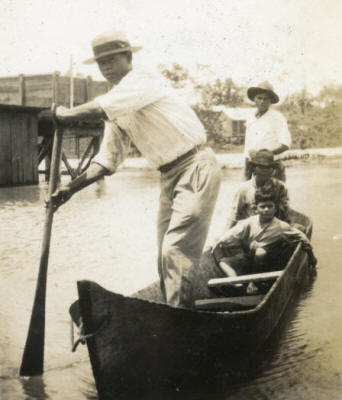 THIS IS THE first PAGE OF
DOCUMENTS FOR THE PERIOD AFTER 1932
on Nicaragua's Caribbean Coast region, housing
documents in the year 1933.
THIS IS THE first PAGE OF
DOCUMENTS FOR THE PERIOD AFTER 1932
on Nicaragua's Caribbean Coast region, housing
documents in the year 1933.
With the US Marines gone,
the Guardia Nacional is now the
country’s supreme military authority
— de jure and de facto
— except in the deep interior zones
centered on the Bocay and upper Coco
valleys and across much of Las
Segovias. Here, Sandino’s Defending
Army has carved out an alternative
jurisdictional space — a kind of
rebel republic with its own laws,
civil and military authorities,
taxation system, forms of identity,
and symbols, myths & legends.
Untenable in the long term, this
fragmented sovereignty would last a
little over a year, until Sandino’s
assassination in Managua on 21
February 1934 at the hands of the
Guardia Nacional and its Jefe
Director Anastasio Somoza García.
The documents on this page
reveal much about social & political
dynamics among Costenos
during this so-called “Year of
Peace." Two
long reports stand out:
Admiral C. H. Woodward’s Report on
the 1932 Nicaraguan Elections (25
January), which conveys a boatload
of information about the Coast in
general and Bluefields politics in
particular; and the sections of the
US Marines’ Monograph of
Nicaragua on the Coast (12
December). Much can be learned
from these two lengthy documents.
Moravian Bishop Guido Grossman
is prolific during the
year, with his long letters of 30
May, 27 June, 31 July, and 4 October
and circular of 7 November offering
another valuable lens on the
Atlantic Coast’s social, cultural,
and religious landscape in the wake
of the US withdrawal. As seen
in his report on his meeting with
the governor of the Comarca of Cabo
Gracias a Dios (30 May), the
Nicaraguan government favors the
Moravians and wishes to be rid of
the Sandinistas, but needs time to
consolidate its control of the upper
reaches of the Río Coco. Who
has power & influence where?
Grossman negotiates with the
Sandinistas for access to the
interior districts and wonders
whether Sandino will allow it, which
of course he does not.
The
spy reports of the Bragman Bluff
Lumber Company / Guardia Nacional,
forwarded to the US Consul in Puerto
Cabezas Sheridan Talbott, are also
noteworthy (in the absence of the
original reports, included here are
only the research notes of David C.
Brooks; inspection of the originals
documents must await the next visit
to College Park MD). The spy’s
report on Abraham Rivera’s band on
the lower Río Coco (“Jakal Centro”,
25 January) sounds very plausible,
and is corroborated by the GN-2
reports covering the end of 1932
cited on the previous page.
Consul Talbott’s January 3 comments
on Henry Springer are pretty
hilarious, but his report is
emblematic of continuing US imperial
muscle-flexing in the absence of an
overt military presence.
An especially colorful,
dramatic, and revealing set of
descriptions of conditions
along the Coast can be found at the
bottom of this page in the letters
of Frank Hilton. These
fascinating letters were added to
this collection in November 2024
thanks to the kind courtesy of
reader Jeff Ehler of West Des
Moines, Iowa. In 1933, the
Minnesota-born oil worker Frank
Hilton basically walked all the way
from Texas to Venezuela, passing
through coastal Honduras and
Nicaragua in November & December.
His letters home describing his
experiences in Nicaragua brim with
illuminating observations and
descriptions and merit a very
careful read. I thank Jeff
Ehler for generously sharing
transcriptions and scans of his
letters and sketch maps tracing his
route.
Not
included here are Sandino’s missives
& circulars concerning his Río Coco
Cooperative on the upper
Coco, which lay well outside the
Caribbean Coast region proper (on
this topic, see the letters from
Granada merchant Daniel Ortega Cerda
[father of latter-day Nicaraguan
president Daniel Ortega Saavedra] to
Sandino proposing a commercial
agreement to market the products of
Sandino’s Río Coco Cooperative, and
Sandino’s response:
EDSN-DOCS: LA COLECCIÓN DANIEL
ORTEGA CERDA).
More
relevant to the core dynamics
shaping the lives of Costeños in
1933 are the “labor
troubles on the banana farms” and
“labor agitators . . . soliciting
funds from the workmen on the farms
for the purpose of organizing a
union” reported by Consul Talbott
(January 3). Further research
would likely reveal much more along
these lines.
In
sum, the EDSN still maintains a
small but viable presence
in a strategically vital section of
the Coast — Abraham Rivera’s band on
the lower Coco — but its military
offensives are a thing of the past
and on the whole its
political-cultural influence remains
miniscule.
|
|
PERIOD MAPS
|
|
1894 mosquito
shore

27 MB,
library of congress
|
1920s
Standard Fruit

6.5 mb,
US National archives
|
1928 Rio wanks
Patrol

3 mb, us
national archives
|
1931 Moravian

2.4 mb,
comenius press
|
|
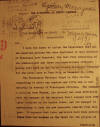
|
1.
3 January 1933.
The Situation at Puerto Cabezas,
US Consul
Sheridan Talbott, Puerto Cabezas,
to Sec. State Wash. D.C., p. 1.
"SIR: ¶
I have the honor to inform the
Department that all the American marines
who were stationed in this district of
Nicaragua have departed, the last five
consisting of two commissioned and three
non-commissioned officers having left
here on the United States destroyer
“Overton” for the naval base at Coco
Sola on December 31, 1932. ¶
The Nicaraguan National Guard in this
section consisting of about one hundred
and fifty men is now entirely in command
of Nicaraguan officers. The commander, a
civilian from Masaya, has already had
some difficulty with the manager of the
American fruit company here over labor
troubles on the banana farms, and the
manager is endeavoring to have the new
commander removed from this post. It
appears that labor agitators have been
soliciting funds from the workmen on the
farms for the purpose of organizing . .
. "
|
|
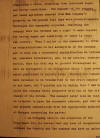
|
2.
3 January 1933.
The Situation at Puerto Cabezas,
US Consul
Sheridan Talbott, Puerto Cabezas,
to Sec. State Wash. D.C., p. 2.
" . . .
organizing a union, promising them
increased wages and better conditions.
The manager of the company had these
agitators removed from the company’s
property on the ground that they were
mischief-makers whereupon the commander
objected, informing the company that the
workmen had a right to make request for
better wages and conditions of labor in
their own country. When I called
on the commander to offer my
congratulations on his assumption of the
command and to wish him a successful
administration he informed me, somewhat
truculently, and, in my opinion,
unnecessarily, that his duty was to
protect Nicaraguans as well as
foreigners --- an obligation which I
have never heard questioned by anybody
here. Whether his remarks were
intended to be transmitted to the fruit
company I do not know, but I quieted him
by saying that I had no doubt the
company would cooperate with him in the
discharge of his duties. The
manager later told me that he intended
to have the commander removed, and that
he had already communicated with the
appropriate authority at Managua
concerning the matter. ¶ I
am bringing this to the attention of the
Department for the reason that any lack
of cooperation between the Guardia and
the company may have an unfortunate . .
."
|
|
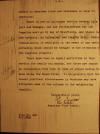
|
3.
3 January 1933.
The Situation at Puerto Cabezas,
US Consul
Sheridan Talbott, Puerto Cabezas,
to Sec. State Wash. D.C., p. 3.
". . .
effect on American lives and interests
in this territory. ¶ There
is now no air-plane service between this
port and Managua, and any correspondence
for the Legation must go by way of
Bluefields, and thence to the interior,
an infrequent and lengthy trip.
Radio communication is available in the
event of any serious situation which
should be brought to the attention of
the Legation promptly. ¶
There have been no bandit activities in
this section for nearly six months, but
there are rumors in circulation from
time to time of groups having been seen
along the Wanks River. It is
possible that the recent political
disturbances in Honduras may have
attracted some of the outlaws to the
neighboring republic. ¶
Respectfully yours, ¶ Eli
Taylor, ¶ American Vice
Consul."
|
|
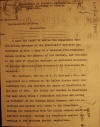
|
4.
3 January 1933.
The Situation at Puerto Cabezas,
US Consul
Sheridan Talbott, Puerto Cabezas,
to Sec. State Wash. D.C., p. 4.
"SIR: ¶
I have the honor to advise the
Department that the Acting Governor of
the Bluefields’ District has furnished
me with a copy of the telegram from
President Sacasa listing the members of
his Cabinet, and included is the name of
Franklin Springer as assistant Secretary
of Foreign Relations (Sub Secretario De
Relaciones Exteriores). ¶
Mr. Springer, the son of H. F. Springer,
Sr., was registered as a citizen of the
United States until his candidacy for,
and election as, mayor of Bluefields in
the fall of 1931. His father has
resided in Bluefields for many years
doing a commission business and acting
as “aviador” of the Bonanza Mines
Company, and his activities are already
well known to the Department through his
connection with the mining company
mentioned and more recently, through his
complaints against the working of the
exchange control regulations. ¶
Mr. . . ."
|
|
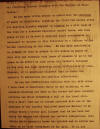
|
5.
3 January 1933.
The Situation at Puerto Cabezas,
US Consul
Sheridan Talbott, Puerto Cabezas,
to Sec. State Wash. D.C., p. 5.
" [missing line]
. . . being a certain amount of physical
courage and some political following
through intimacy with the Negroes in
Bluefields. ¶ He has made little
effort to administer the position of
mayor of Bluefields, spending the first
few months after his election largely
engaged in digging in a hill back of the
town for a treasure reputedly buried
there, and even going so far as to wear
a peculiar scarf recommended as
necessary to success in this direction
by a fortune teller he was consulting at
the time. He has made practically
no attempt of late to attend to his
duties as mayor of this city and
recently took leave of absence to go to
the mines in an effort to look after his
father’s interest as the mine has been
operating under difficulties of late.
However, it is generally believed that
he lacks the capacity to administer any
position effectively. ¶ He
has had difficulties publicly with his
wife since I have been in Bluefields
while he was drinking, on one occasion
knocking her down on the street and more
recently striking her while attending a
ball at the local club. Only a
short time ago he became involved with
one of the officers of the Guardia
(enlisted American marine) in
an affair
where a creole girl alleged that he had
held her while the marine had offered
her certain indignities;
this affair while generally known was
quieted and no action was taken as at
first threatened by the girl. It
is not . . . " [my emphasis]
|
|
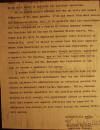
|
6.
3 January 1933.
The Situation at Puerto Cabezas,
US Consul
Sheridan Talbott, Puerto Cabezas,
to Sec. State Wash. D.C., p. 6.
" [missing
line] . . . negro. The foregoing
are a few of a number of incidents which
will serve to indicate his personal
character. ¶ He is
politically a Liberal and was an early
and ardent supporter of Dr. Enoc Aguado.
I am not aware from what course his
influence arises, but, it is possible
that his appointment has been influenced
by a desire to obtain harmony between
the factions led by him and by General
Eliseo Duarte, who, rumor has it, will
be appointed Governor (Jefe Politico) of
Bluefields. Also, it should be
noted that the only appointments from
Bluefields so far have been men
registered, or formerly registered as
Americans; Joseph Harrison, appointed a
captain in the Guardia, was at the time
registered as an American citizen, and
Mr. Springer was registered at the time
he became a candidate for mayor. ¶
I assume that there is nothing that can
be done in the matter, but it appears
unfortunate that the new Government
should initiate its administration by
selecting persons for office so
obviously unfit as Mr. Springer.
While, General Duarte is better
qualified for the position which rumor
indicates he will occupy, his
appointment offers no encouragement that
honest and capable officials may be
expected to administer the affairs of
this coast during the coming difficult
period. ¶ Respectfully
yours, ¶ Sheridan Talbott,
¶ American Consul."
|
|
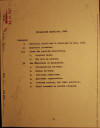
|
1.
25 January 1933.
Report on the 1932 Nicaraguan Elections,
Admiral C. H.
Woodward, Chairman of the US
Electoral Mission to Nicaragua, p. 1.
"Synopsis:
¶ I Political conditions in
Nicaragua in July, 1932. ¶
II Electoral procedure. ¶
III Plans for American supervision.
¶ 1. Original plans. ¶
2. The plan as adopted. ¶ IV
The Department of Bluefields. ¶
1. Topographical features. ¶
2. Racial features. ¶ 3.
Political conditions. ¶ 4.
Electoral organization. ¶ 5.
Problems arising, and their solutions.
¶ 6. Final comments on results
attained."
|
|
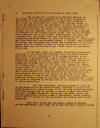
|
2.
25 January 1933.
Report on the 1932 Nicaraguan Elections,
Admiral C. H.
Woodward, Chairman of the US
Electoral Mission to Nicaragua, p. 2.
"I.
POLITICAL CONDITIONS IN NICARAGUA IN
JULY, 1932. ¶ The
resignation of President Emiliano
Chamorro on 30 October 1925 was the
beginning of the period of American
intervention which terminated on 2
January 1933. Chamorro had seized
the government by a coup d’etat and was
unable to secure recognition from the
Department of State in Washington.
After the presidency had become vacant
eighteen congressmen who had been
expelled by Chamorro were persuaded to
return to Managua and the Congress,
which was assembled at once, elected as
president of the republic Senor Adolfo
Diaz who had formerly been president
from 1911 to 1916. Both Chamorro
and Diaz were Conservatives. The
regime which was overthrown in 1926 were
Conservatives. The regime which
was overthrown in 1926 was a coalition
government headed by President
Solorzano, a Conservative, and Vice
President Juan Bautiste Sacasa, a
Liberal. When Chamorro had seized
the government and forced the
resignation of Solorzano, Sacasa fled
the country in fear of losing his life
and went to Mexico where he gathered
about him a small group of sympathetic
supporters. ¶ In December,
1926, Dr. Sacasa, vigorously maintaining
his right to the presidency accruing to
him by constitutional provision upon the
resignation of Solorzano, returned to
the east coast of Nicaragua with a small
armed force and set up a provisional
government of his own at Puerto Cabezas.
Mexico accorded him instant recognition.
Armed conflict with the Diaz government
began at once and the East Coast became
the theater of a revolutionary campaign
of considerable proportions. Volunteers
flocked to the Sacasa banner. Basing his
action on requests from the British,
Belgium, Italian and Chinese governments
that their nationals be given protection
in the disturbed area, and convinced
that Mexico for reasons of her own was
giving active support to the Sacasa
forces, President Coolidge intervened
and landed marines on the East Coast,
justifying his actions in a note to
Congress by stating that he was acting
on the grounds of public expediency. ¶
The Diaz government, having purchased a
quantity of war materials in the United
States, attempted to destroy the
revolutionaries by force of arms but it
met with decided reverses. While
the Sacasa army was winning a series of
short skirmishes and small battles
between Rio Grande Bar and Pearl Lagoon,
the marines established neutral zones at
Bluefields, Puerto Cabazas, and on the
Rio Grande for the protection of
American and foreign interests. ¶
Just after Sacasa had initiated a march
on Managua and his successful,
well-armed troops had started and
advance across . . . "
|
|
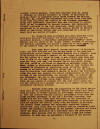
|
3.
25 January 1933.
Report on the 1932 Nicaraguan Elections,
Admiral C. H.
Woodward, Chairman of the US
Electoral Mission to Nicaragua, p. 3.
". . . country
towards Managua. President
Coolidge sent Mr. Henry L. Stimson, at
present Secretary of State, to Nicaragua
to make an effort to negotiate peace
terms between the warring factions.
Mr. Stimson was successful and both
sides laid down their arms following the
signing of the Tipitapa Agreement.
Under this agreement, President Dias was
continued in office until he was
superseded by General Moncada, the
successful Liberal candidate in the 1928
elections. These elections were
supervised by an American Electoral
Mission headed by General McCoy of the
United States Army and conducted by a
group of Army, Navy and Marine officers.
¶ Dr. Sacasa’s army disbanded and
peace probably would have been restored
throughout the entire republic had not
Augustino Sandino, a relatively
insignificant “general” under Moncada
who was chief of the Sacasa forces,
refused to recognize the Tipitapa
Agreement and opened a guerilla warfare
which, up to the present time, has not
been brought under control. ¶
Thus Jose Maria Moncada became president
of Nicaragua after the 1928 election and
the second phase of the American
intervention period began.
President Moncada was a Liberal.
Some years before he became a general in
the Sacasa revolution, he was the editor
of a paper in Leon, a man without much
fame and with little if any money.
Most editors and publishers in Nicaragua
are very poor men, and Moncada was no
exception. During his four years
as president he amassed an extremely
large fortune, judged by Nicaraguan
standards. Most of this fortune
was invested in Nicaragua by purchasing
under favorable terms a number of
extensive agricultural properties.
It was the impression in Nicaragua that
Moncada’s desire to retain the
presidency after his term had expired
(in direct contravention of the
provisions of the constitution) or,
failing that, to control the new
incumbent, was due to his apprehension
over possible loss of his personal
fortune which might follow a
Conservative victory. He was
almost as worried over the loss which
might follow the election of a Liberal
who was not a member of his own
particular political coterie. ¶
Moncada first made the suggestion to the
State Department that he be permitted to
serve beyond his normal and legal term
in order to effect economy in government
expenditures, i.e. that the
poverty-stricken national government
would save the large expense necessary
to pay for a national election.
This suggestion was not acted upon
favorably by the Secretary of State in
Washington. Moncada’s next move
appeared to be an effort to disrupt the
Liberal party with the object of
dividing the Liberal votes between two
separately nominated Liberal candidates.
This would make it probable that no
candidate would secure the necessary
plurality in the general election and
would throw the final selection of a
president into the Nicaraguan Congress.
Here Moncada felt he controlled a large
and potent majority. To this end,
he persuaded a faction of the Liberal .
. . "
|
|
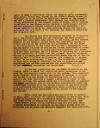
|
4.
25 January 1933.
Report on the 1932 Nicaraguan Elections,
Admiral C. H.
Woodward, Chairman of the US
Electoral Mission to Nicaragua, p. 4.
". . . party to
call a convention before the regular
party convention. This group,
having met, placed in the field a
Liberal ticket or “formula” as it is
called in Nicaragua, headed by one
Arguello who was a staunch Moncadista.
This formula was received with little
enthusiasm by the Liberal party at
large, and by violent opposition by the
Sacasa group. Perhaps a month
later, the regularly scheduled Liberal
convention met and nominated a national
formula in which Dr. Juan Bautista
Sacasa was named as candidate for
president. A Dr. Espinosa was
named as candidate for five-president.
¶ Dr. Sacasa had been Nicaraguan
Minister to Washington under the Moncada
regime and was certainly the most
popular Liberal who could have been
placed in the field. He had
opposed himself to the Moncada clique
which was ruthlessly trying to retain
control of the party and the government.
He was known to be pro-American in the
sense that he was a sympathizer with the
expressed policies of the United States
Department of State, particularly in
regard to Latin-American relations.
His education had been thorough (he is a
doctor of medicine and a graduate of the
University of Paris) and his culture,
happily expressed through a charming,
gracious personality makes him one of
the outstanding men of affairs in
Nicaragua. His integrity is
unquestioned. He is handicapped, I
fear, by his altruistic attitude of mind
which makes it difficult for him to
appreciate or comprehend the selfish
motives and the pernicious political
activities of his associates and
supporters. ¶ To further
complicate the political situation in
the Liberal party, a small but
vociferous group endeavored to secure
the presidential nomination for Dr.
Aguado [Enoc Aguado], Vice-president
under Moncada. This group was
encouraged by Moncada to advance its
claims with the object of undermining
some of the Sacasa support and thus
throwing a larger component of power to
the Moncada faction. The Aguado
group was not successful in nominating
their candidate, but it did develop
considerable power and undoubtedly
secured from the Sacasa faction at the
post-convention conference important
concessions which assured it of
participation in the new government of
Dr. Sacasa if and when he was elected.
¶ Thus, when the Electoral Mission
arrived in Managua in July, 1932, it
found two Liberal formulas in the field,
each regularly nominated by a convention
which claimed for itself the legal power
of naming the party’s national ticket.
The Conservative party whose convention
had not yet been held, appeared
determined to nominate ex-President
Adolfo Diaz for president and
ex-President Emiliano Chamorro for
vice-president. . . ."
|
|
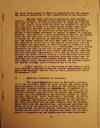
|
5.
25 January 1933.
Report on the 1932 Nicaraguan Elections,
Admiral C. H.
Woodward, Chairman of the US
Electoral Mission to Nicaragua, p. 5.
". . . The
party later agreed on these two
selections and they became the official
candidates of the conservatives in the
election. ¶ Shortly after
arriving in Nicaragua, Rear Admiral
Clark H. Woodward, Chairman of the
National Board of Elections and Chief of
the U.S. Electoral Mission to Nicaragua,
decided that the Liberal Party could not
have two formulas in the field but would
have to agree on a single party ticket.
Over President Moncada’s personal
protest to the Department of State,
which as forwarded to Washington by the
American Minister in Managua without
prior reference to Admiral Woodward, he
(Admiral Woodward) directed that a third
convention be held by the Liberal party
for the selection of an official ticket
which could be recognized by the
Mission. An exhaustive legal
investigation into the matter revealed
the fact that there was no way by which
the legality of either one of the
earlier conventions could be determined.
The Department of State declined to
interfere with the action of Admiral
Woodward. As a consequence, a
third Liberal Convention was held in the
city of Leon and Dr. Sacasa and Dr.
Espinosa were nominated as the Liberal
candidates for president and
vice-president respectively. Prior
to and during this convention, the three
Liberal factions I have mentioned
undoubtedly made definite agreements
affecting important selections for
political and military appointments
because thereafter the entire Liberal
party wholeheartedly supported the
national ticket and serious internal
party dissension was at an end. ¶
This, briefly, is a description of the
state of political affairs in Nicaragua
when the various Departmental Chairman
of the Electoral Mission took up their
pre-election duties in September, 1932.
¶ II. ELECTORAL PROCEDURE IN
NICARAGUA. ¶ The superior
electoral body in Nicaragua, provided
for in the so-called Dodds Law which
governs the entire electoral procedure
at present, is known as the National
Board of Elections (Consejo Nacional de
Elecciones). It consists of a
chairman, appointed by the President of
the Republic, and two political members,
one each from the Liberal and
Conservative parties, who are nominated
by the national “juntas” of those
parties. Each party “junta”
nominates a “suplente” (assistant)
political member who sits on the board
only in the absence of his principal.
The National Board appoints its own
secretary and other assistants such as
legal advisor, etc. The National
Board interprets the electoral law,
adjudicates questions submitted to it by
the national parties and their
candidates and by departmental boards of
election, verifies the departmental
reports on the result of the election
and makes its own final report to
Congress when the final count has been
determined. . . . "
|
|
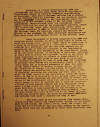
|
6.
25 January 1933.
Report on the 1932 Nicaraguan Elections,
Admiral C. H.
Woodward, Chairman of the US
Electoral Mission to Nicaragua, p. 6.
". . . Nicaragua
is divided geographically into
sub-governmental and sub-political areas
known as departments. Departmental
Boards of Election (Consejos
Departmentales de Elecciones) each have
a chairman selected and appointed by the
National Board of Elections, and the
political members and two suplentes
appointed by the departmental board but
nominated by the national juntas of the
two major parties. Departmental
Boards appoint their own secretaries.
Those boards supervise the work of the
subordinate electoral bodies (the
directories) under their jurisdiction,
decide local questions submitted to them
or refer debatable questions to the
National Board for decision, collect and
tabulate the results of the election for
their respective departments and make
their final departmental reports to the
National board. ¶ Every
department is divided geographically
into subdivisions called cantons.
In every canton there is placed at least
on voting place called a “mesa” which is
controlled by a group of officials known
as a “directorio”. A directorio
consists of a president, and two
political members and two secretaries
all of whom are appointed by the
Departmental Board of Elections upon
nomination of the departmental juntas of
the two major parties. If
personnel is available, suplentes to
these five officials are appointed to
act in the place of their principals in
case of illness or other inability to
serve. The departmental junta of
each party is privileged and expected to
appoint for duty as each mesa two
vigilantes or watchers whose duties are
to scrutinize voters of the opposite
party and to instruct adherents or their
own party in the correct method of
casting properly marked ballots.
The directorio is charged with the
duties of registering voters during the
registration period and, on election
day, of receiving, recording and
counting the votes cast. It makes
it final report to the departmental
board. The directorio, as far as
it is able to do so, settles local
disputes, especially those involving the
qualifications of voters, and refers to
the departmental board such questions
upon which it cannot agree. It
will be observed that a complete
directorio consists of five regular
members and four vigilantes which makes
a total active personnel of nine men.
To this may be added from five to nine
suplentes who are standing by to take up
the duties of their principals when
necessary. Since military guards
are detailed for duty at all means of
registration and election days, the
group of government officials and
employees form quite a considerable body
of men. ¶ The presidents of
the directorios were chosen
alternatively from the Liberal and
Conservative parties. In the
Department of Bluefields, the Liberal
party, being the larger, was given the
first selection. The political
members on the Departmental Board were
the instruments by which these
selections were made. . . . "
|
|
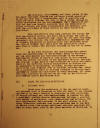
|
7.
25 January 1933.
Report on the 1932 Nicaraguan Elections,
Admiral C. H.
Woodward, Chairman of the US
Electoral Mission to Nicaragua, p. 7.
". . . The
national, departmental and local juntas
of the two major political parties are
political bodies recognized by law and
they play a considerable part in
electoral and other political affairs.
Not only do these juntas indulge in
active propaganda for the candidates of
their respective parties but they are
usually consulted when the nomination of
public officials are under consideration
and generally control the activities of
their parties in their respective
localities. ¶ Five
registration days were provided for
during the 1932 pre-election period, the
first being Sunday the 18th of September
and the successive ones being the two
next following Wednesdays and Sundays.
The last registration day was the 2nd of
October upon which date the inscription
lists were finally closed. The
election occurred on the 6th of
November. ¶ In the 1932
election, the presidency,
vice-presidency and secretaryship of the
National Board of Elections, and the
presidencies and vice-presidencies of
the several Departmental Board of
Election were filled by appointments
from the officer personnel of the
Electoral Mission. Enlisted men
attached to the Mission were appointed
as clerks and assistants at the
Electoral Mission headquarters in
Managua and directorios were presided
over by selected enlisted men.
There was a considerable staff of
officers attached to Mission
headquarters as chiefs and assistants of
staff sections. All other
officials connected in any way with
their work of the Electoral Mission were
native Nicaraguans. ¶ III.
PLANS FOR AMERICAN SUPERVISION ¶
1. Original Plan. ¶ Based
upon the experience of the two earlier
American missions sent to Nicaragua in
1928 and 1930, it was planned originally
to send a mission to Nicaragua in 1932
consisting of enough officers and
enlisted personnel to provide not only a
completely staffed Mission Headquarters
but also a considerable number of
assistants, both commissioned and
enlisted, for each departmental
headquarters. It was also planned
to have every directorio presided over
by an enlisted man of the Navy or Marine
Corps with enough additional enlisted
personnel present at every mesa, even in
the quiet sections of Nicaragua, to . .
. "
|
|
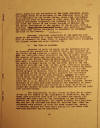
|
8.
25 January 1933.
Report on the 1932 Nicaraguan Elections,
Admiral C. H.
Woodward, Chairman of the US
Electoral Mission to Nicaragua, p. 8.
". . . form a
guard for the protection of the local
electoral group. The entire force
to be assigned to the Electoral Mission
was to be assembled in the United
States, given some preliminary training
and sent to Nicaragua in July, 1932.
The Electoral Mission detachment
originally was intended to be a force
over and above the forces of the second
Brigade of Marines and the Marine
Detachments of the vessels of the
Special Service Squadron, which were
expected to supply the additional guards
that might be necessary in disturbed
sections of the country. ¶
However, political opposition in the
American Congress to the sending of a
large electoral mission to Nicaragua
made it necessary in June, 1932, to
abandon this first suggested and planned
scheme and adopt another one. ¶
2. The Plan as Adopted. ¶
Animated in part, at least, by the
determination to conserve the
expenditure of public funds, the
Congress of the United States inserted a
clause in the Naval Appropriation Bill
for 1932-1933 which prohibited the use
of public funds for sending officers and
enlisted men of the Navy and Marine
Corps from the United States to
Nicaragua for electoral duty. This
made it impossible for the Major General
Commandant of the Marine Corps to assign
to the Electoral Mission the two groups
of enlisted men then (in May, 1932)
undergoing special training at Quantico
and San Diego. The United States
Electoral Mission to Nicaragua thereupon
was forced to rely upon the Second
Brigade of Marines, then in Nicaragua,
and the Marine Detachments of the
Special Service Squadron for assistance
in its supervision of the 1932 election.
A group of about thirty Naval and Marine
officers, already having been designated
for duty with the Mission, were directed
to report on board the U.S.S. Henderson
at Hampton Roads, Virginia, before
midnight of 30 June 1932 (the transport
was scheduled leave that port for
Cristobal and Corinto on 8 July) in
order to permit the payment of their
land transportation out of the 1931-1932
appropriations. ¶ The
significance of this change in plan can
be appreciated by its effect on the
Department of Bluefields. The
original plan specified that five (5)
officers and ninety (90) enlisted men
would make up the contingent of the
Electoral Mission for that department.
The number actually sent last summer was
two (2) officers and nine (9) enlisted
men. Other departments were
reduced in about the same proportion,
except in Granada, Managua and Leon
where nearly all the mesas were assigned
enlisted men as presidents. . . . "
|
|
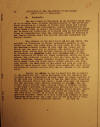
|
9.
25 January 1933.
Report on the 1932 Nicaraguan Elections,
Admiral C. H.
Woodward, Chairman of the US
Electoral Mission to Nicaragua, p. 9.
". . . IV.
ACTIVITIES IN THE DEPARTMENT OF
BLUEFIELDS (EAST COST OF NICARAGUA) ¶ B.
Geography. ¶ The East Coast of Nicaragua
is an alluvial plain from 30 to 75 miles
wide, divided perpendicularly to the
north-and-south shoreline by a number of
rivers upon which are located the most
important and settlements. Inland
communication between these rivers is
almost impossible and up-river garrisons
can be supplied, reinforced or relieved
only by sea-and-river lines of
communication from the principal towns
of Bluefields and Puerto Cabezas where
the Guardia Nacional maintains it
largest forces. ¶ The climate on the
East Coast is wet and humid. The
rainfall in Bluefields is almost
invariable amounts to 188 inches per
year. The rains begin in late April or
early May; the maximum rainfall occurs
in July when the rivers are in flood;
and the rains end in January. The entire
population, except those living near
natural sources of potable water, is
dependent for drinking water upon
accumulations of rainwater collected in
tanks and other containers during the
rainy season. The principal staples of
food are rice, beans, beef, fish,
plantains, bananas (usually prepared by
being boiled in their green state and
eaten like a boiled potato), and
tropical fruits. Few residents of the
coast eat corn or corn products in which
respect they differ from nearly all
other native residents of Central
America from the Rio Grande to the
Panama Canal. ¶ Beyond the plains to the
westward lie the foothills of the
mountains that divide Nicaragua into two
separate and distinct areas. Intercourse
between these two areas normally is by
the slow and tortuous route of the San
Juan river (location of the proposed
Nicaraguan Canal). Lakes Nicaragua and
Managua and the railroad whose eastern
terminus is Granada. The few direct
trails involve long, arduous rides or
marches through a veritable wilderness
of uninhabited terrain and are seldom
used except by cattle buyers or
marauding bandit groups. Coastwise
traffic is born by small but seaworthy
schooners. The San Juan river traffic is
carried by small barges towed by
gasoline launches. There is a fair sized
lake steamer on Lake Nicaragua which
makes the round trip of the lake once a
week. Travel facilities are primitive
indeed. It will be . . . "
|
|
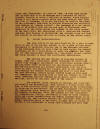
|
10.
25 January 1933.
Report on the 1932 Nicaraguan Elections,
Admiral C. H.
Woodward, Chairman of the US
Electoral Mission to Nicaragua, p. 10.
". . . noted that
Bluefields, in point of time, is four
days nearer New Orleans than it is to
Managua and a resident of Puerto
Cabezas, wishing to visit a relative in
Ocotal, finds himself facing at trip
which requires about the same time as
that from New York to Yokohama. It
is not difficult to realize that most of
the government functions in Eastern
Nicaragua are regulated from Managua by
"remote control". The purchase of
large quantities of foodstuffs from the
western part of Nicaragua, made
necessary by the undue length and
wetness of the rainy season on the East
Coast, has encouraged quite a
considerable freight business from
Granada to Bluefields. The freight
rates are high and operate to increase
the cost of living on the entire coast.
¶ 2. Racial characteristics.
¶ The true native of the East
Coast is (1) a pure blooded negro of one
of the coastal tribes; or (2) a pure
blooded negro descendent of emigrants
from any one of the European colonies in
the Caribbean area who have lived in the
region for several centuries; or (3) a
cross-breed of these two strains.
The Spanish (or West Nicaraguan) element
is a relatively recent arrival.
The white element is small and
politically unimportant. ¶
The Indians are the "hewers of wood and
drawers of water". They are a
suppressed class, protected in their
land rights with treaties, agreements
and conventions between Great Britain,
under whose protection the old Mosquito
government existed and Nicaragua who
assumed sovereignty over the East Coast
in 1898, but cheated and imposed upon by
all other classes particularly the
Spanish Nicaraguans who seem to look
upon the more favorably located Indian
reserve lands as fair game for
themselves. The Indians vote as
they are ordered to vote by their
immediate superior whether he be chief,
labor foreman, employer, priest or
political jefe of the canton. ¶
The negroes, known locally as Creoles,
are important politically and
economically. They control a
little better than half of the political
power. They are engaged in the
professions, in trade and in
agriculture. The Spanish
Nicaraguans are exercising increasing
power owing to their close affiliations
with the governments in Managua.
While the Creoles and the "Spaniards"
are antagonistic locally, possessing as
they do their separate clubs and social
organizations and rarely intermarrying,
it is remarkable how they combined
against the "interior" when governmental
questions arise on the coast.
Another fact is worthy of record. I was
astonished to learn that probably not
more than . . . "
|
|
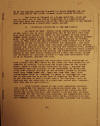
|
11.
25 January 1933.
Report on the 1932 Nicaraguan Elections,
Admiral C. H.
Woodward, Chairman of the US
Electoral Mission to Nicaragua, p. 11.
" . . . 6% of the
Spanish speaking element can speak
English and not more than 10% of the
Creole element speak Spanish fluently.
¶ The coast is Liberal by a large
majority. About one out of every
six of the voting population is a
Conservative. This fact made the
supervision of the 1933 election in the
Department of Bluefields a relatively
simple matter. ¶ 3.
Political conditions on the East Coast.
¶ In spite of their formal party
affiliations, residents of the coast,
due to their insularity and to the fact
that they have been sadly milked for
years by the payment of high import
duties which accrue solely to the
advantage of the central government, are
thoroughly agreed upon a slogan which
may be briefly given as "The Coast for
the Costenians". Both parties
voice this sentiment in all pre-election
speeches and pamphlets, and this
unanimity of feeling tones down
political antipathies and greatly
lessens the tension between the Liberals
and Conservatives. Another
influence for political amity is the
racial groupings where Liberal and
Conservative negroes and Liberal and
Conservative "Spaniards" belong to the
same social organizations within the
racial groups and tolerance on political
matters is much more noticeable than it
is in Granada, Managua and Leon. ¶
The presidential and vice-presidential
candidates of both parties were
well-known on the coast and were
generally recognized as capable,
representative Nicaraguans of the better
class. After a study of the
situation in July, I reached the
conclusion that the election in the
Department of Bluefields would pass
without incident if the national juntas
in Managua would keep their hands off.
There was some fear that local
disturbances would be "ordered" at mesas
on registration days and on election day
with the view of reducing the votes cast
in the election to such a point that a
"no election" would be declared and the
selection of a president thrown into
Congress. This fear did not
materialize. ¶ Both parties
placed in the field eminently
satisfactory candidates for senator and
senator-suplente and, in three districts
of the department, quite respectable
candidates for deputy and
deputy-suplente. The Liberal party
was well provided with funds for the
pre-election campaign; the Conservative
party virtually had none. The
Liberals hired boats, provided food and
refreshments, distributed campaign
buttons, rosettes and banners, . . . "
|
|
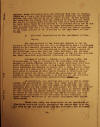
|
12.
25 January 1933.
Report on the 1932 Nicaraguan Elections,
Admiral C. H.
Woodward, Chairman of the US
Electoral Mission to Nicaragua, p. 12.
". . . employed
bands on registration and election days
and, in general, conducted a lively and
thoroughly organized campaign. The
Conservatives were not able to do any of
these things. On one occasion the
candidate for deputy from the district
of San Juan del Norte was unable to
raise eight dollars for boat fare from
Bluefields to Punta Gorda where he was
anxious to be present during one of the
days of registration. The lack of
funds undoubtedly reduced the
Conservative vote but I do not believe
it had any effect whatever on the final
outcome of the elections in the
Department of Bluefields. ¶
4. Electoral Organization in the
Department of Bluefields. ¶
The headquarters of the Electoral
Mission in the Department of Bluefields
was the city of Bluefields where I
stationed myself as Departmental
Chairman with six (later five) marines.
This community of about 10,000
inhabitants is the political center of
the East Coast where the Governor (Jefe
Politico), the justices of the Court of
Appeals, the Area Commander of the
Guardia Nacional and other important
departmental officials are stationed.
¶ Lieutenant Walter I. Jordan,
U.S. Marine Corps, was Vice-Chairman of
the department and was stationed with
three marines at Puerto Cabezas located
as I have previously mentioned about 125
miles to the north. We had regular
mail service between ourselves and
Managua by planes once a week.
Special plane trips were not infrequent
so that we had ample means at hand to
make trips to Managua or from Puerto
Cabezas to Bluefields and return at
almost any time. Without the
assistance of the air squadrons of the
Second Brigade, I do not see how the
Electoral Mission could have functioned
satisfactorily. ¶ At
Bluefields, one enlisted man acted as
office assistant to the Departmental
Chairman. Four other enlisted men
were designated presidents of the four
mesas in Bluefields. The other
remaining enlisted man (extra and
unassigned) was used for investigation
until he was returned to Managua early
in October. He was not replaced.
In Puerto Cabezas, one enlisted man was
office assistant to the vice-chairman
and the two additional men were assigned
presidents to the two mesas in that
community. All other electoral
officials in the entire department were
native Nicaraguans. ¶ There
were fifty two directorios in the
Department of Bluefields scattered
widely throughout the entire area from
the Rio Coco to the San Juan River (see
map attached). The electoral . . .
"
|
|
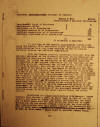
|
13.
25 January 1933.
Report on the 1932 Nicaraguan Elections,
Admiral C. H.
Woodward, Chairman of the US
Electoral Mission to Nicaragua, p. 13.
". . . personnel
assigned as follows: ¶
[Chart] ¶ In addition to the
regular appointments listed above about
two hundred (200) additional native
Nicaraguans were designated suplentes to
a very large majority of the presidents,
political members and political
secretaries. ¶ With the
limited clerical assistance available
from the enlisted personnel of the
Electoral Mission, it was necessary at
Departmental Headquarters from time to
time to employ native assistance for
typing the resolutions of the National
Board for distribution to the various
directorios and for bundling and
dispatching electoral stationery and
ballots as the latter were received from
Managua. The attached map of
Nicaragua showing the locations of the
mesas in the Department of Bluefields
will give a fair idea of the problem
involved in sending out supplies and
ballots to the presidents of the several
directorios, particularly if one bears
in mind the time-distances involved and
the irregular and primitive
transportation facilities available.
Plane drops were utilized when shipments
went astray and were lost en route to
the destination. Occasionally
special and urgent instructions were
dropped by planes in the mining area
around San Pedro de Pispis which was the
most inaccessible section of the
department. As a matter of fact,
these matters of supply and
communication and the collection of the
electoral returns after the election
proved to be my own chief concern during
the entire period. ¶
Bluefields had radio communication with
Managua, Puerto Cabezas, Cabo Gracias a
Dios, El Gallo (near La Cruz on the Rio
Grande), San Pedro de Pispis and Wauni.
Unfortunately the radio set at Wauni
broke down two days before the first day
of registration and did not resume
service until after the election so that
communication with that remote locality
was impossible except by plane drops, or
by mail by which means a reply might be
expected in six weeks. . . . "
|
|
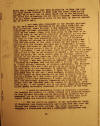
|
14.
25 January 1933.
Report on the 1932 Nicaraguan Elections,
Admiral C. H.
Woodward, Chairman of the US
Electoral Mission to Nicaragua, p. 14.
" . . . There was
a telegraph line from Bluefields to Rama
and also one from Puerto Cabezas to Mesa
Farm and other directories located on or
near the railroad which ran to the
northwest for about 125 kilometers out
of Puerto Cabezas. Communication
with all other directories could be had
only by special messenger or native
mail. ¶ I had been Area
Commander of the Guardia Nacional in the
Department of Bluefields in the years
1929-1931 so, upon my arrival there in
1932, I was familiar with local
conditions and knew personally almost
every man of importance on the coast.
Since form this group of men were to be
selected most of the native electoral
officials, it was fortunate that I knew
the personalities of these individuals
and they in turn knew something about
me. I had achieved some measure of
success in establishing friendly
relations with the residents of the
coast during the two years I was serving
with the Guardia Nacional and I
determined to maintain these relations
if possible on the same cordial basis
during the short period I was to be in
Bluefields on electoral duty. Of
course, I had no formal rules to govern
my own personal conduct but it may be of
interest to record a few "principles"
which certainly had their effect upon my
attitude toward classes of the native
populace. First of all, I
endeavored on all occasions to treat the
native with consideration and courtesy.
In this I was only dealing in the same
coin I received. I trusted the
native, and let him know I trusted him,
until he proved himself unworthy of
further confidence. The failures
were not more than one would expect in
an American group of the same size.
It was necessary to exercise patience –
and then considerably more patience.
I think this was the most difficult task
of all but I must confess, looking back,
the natives appear to have manifested as
much patience without apparent effort as
I did with a good deal of strain.
If correctional action was necessary, I
acted quickly and was sure that the
individual directly concerned and
everyone else connected with the
incident knew the reason for my action.
Needless to say, I was careful not to
act under these circumstances until I
was thoroughly convinced of the justice
of the step. ¶ I found in
Lieutenant Jordan an excellent assistant
who handled his affairs at Puerto
Cabezas in a splendid manner. We
were in such thorough accord that upon
no occasion was it necessary for me to
inject myself into any matter that
Lieutenant Jordan was competent legally
to decide himself. ¶ The two
political members of the Departmental
Board of Elections were representative
and cooperative men from the liberal and
Conservative parties. The Board
appointed as secretary a Nicaraguan who
was a proficient interpreter and . . . "
|
|
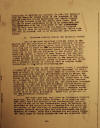
|
15.
25 January 1933.
Report on the 1932 Nicaraguan Elections,
Admiral C. H.
Woodward, Chairman of the US
Electoral Mission to Nicaragua, p. 15.
" . . .
translator of English and Spanish.
He also was familiar with the Mosquito
tongue which is the language of the
Indians resident around Bluefields and
Puerto Cabezas and on the lagoons along
the entire East Coast. This man
was of great assistance to me in my
interviews and correspondence with the
presidents of the directories some of
whom were familiar with the English
language only and for whom all electoral
instructions (which were received in
Spanish) had to be translated into their
own tongue. ¶ 6. Problems
arising during the election period.
¶ One of the most important
problems faced by the Mission was the
selection of the native personnel for
electoral duty. I rather easily
solved this problem by making it a rule
not to agree to an appointment unless
both political members of the
Departmental Board of Elections were
favorable to the persons nominated by
the Liberal and Conservative juntas.
I think not over three or four men were
replaced later on complaint of either
one of the parties. I knew
personally all of the members of the
executive committee of both departmental
juntas in Bluefields and it was not a
difficult matter to persuade them to
confine their nominations to reasonably
fair-minded men. ¶ As
president of the departmental board, I
addressed a letter to all of the native
electoral personnel. In this I made an
effort to appeal to their sense of
fairplay and asked them to cooperate
with the departmental board in making
the election on the East Coast a true
and faithful record of the wishes of the
people. While the letter was
issued more or less as a formality, I
was much surprised at the native
response to it. With possibility
three exceptions, the Nicaragua
personnel responded to a man and gave
the Electoral Mission entire
cooperation. In the five months of
the pre- and post-election period only
two incidents transpired which I
consider worthy of record to illustrate
the types of annoyance which were
unexpected to be of daily occurrence.
These will be related in the next
succeeding paragraphs. ¶ The
first incident took place in Lieutenant
Jordan’s bailiwick, not far from Puerto
Cabezas. At an isolated mesa, Mesa
Farm, where the population was
overwhelmingly Liberal, it fell to the
lot of the Conservative party to
nominate the president of the directorio
and a Conservative was appointed to
preside. On the first day of
registration, a group of disgruntled
Liberals charged this man with
drunkenness and intimidation of voters,
swore out a warrant for his arrest
before the local judge at Puerto Cabezas
and had the electoral official . . . "
|
|
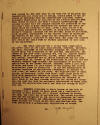
|
16.
25 January 1933.
Report on the 1932 Nicaraguan Elections,
Admiral C. H.
Woodward, Chairman of the US
Electoral Mission to Nicaragua, p. 16.
". . . locked up. The idea back of
the move was to frighten the
Conservative and force him to resign.
Jordan heard of the incident by
telephone from the Conservative
political member, preceded immediately
by railroad to the station nearest Moss
Farm (about 60 miles) and made a hurried
investigation. He quickly decided
that the charges against the president
of the directorio were without
foundation and ordered the man’s release
which was effected at once. Later
a full report with supporting affidavits
was received in Bluefields confirming
Jordan’s original findings and the
National Board of Elections, at my
request, recommended to the Supreme
Court of Nicaragua the removal of the
local judge who had interfered with the
orderly electoral procedure at Moss
Farm. The judge was removed from
office and there were no further
incidents of this kind the department.
¶ The other incident was a little
more complicated and not so clear in the
legal implications. Senators,
deputies, and their suplentes of the
National Congress are immune from arrest
under the provisions of the national
constitution. The leader of the
East Coast Liberals was, and is, Senator
Onofre Sandoval. He is an
aggressive, clever, rather unscrupulous,
bull-voiced, corpulent man of Indian
extraction who had been an intimate of
Dr. Sacasa in the revolution of 1927 and
who was presently offered (and refused)
the appointment of Minister of
Agriculture in the Sacasa cabinet.
Sandoval draws a good deal of water and
knows it. Last summer he was
running the Liberal departmental junta
in Bluefields. As his own
contribution of personal services to
pre-election propaganda, he decided to
look after, on behalf of his party, the
registrations at Pearl Lagoon, an
important little town about eight hours
north of Bluefields accessible through
an island waterway. The local
problem at Pearl Lagoon was one
involving the dispatch of small boats up
the many streams entering the lagoon and
bringing down into the town the
scattered inhabitants of these rural
sections for registration first, and
then for voting on election day. ¶
Sandoval preceded to Pearl Lagoon on the
16th of September with a number of small
boats and a considerable quantity of
food supplies for a Liberal barbeque on
Sunday the 18th, the first day of
registration. The second
registration day was designated as the
following Wednesday the third the
following Sunday. All directorios
had received instructions to register
voters on all five of the designated
registration days. The 18th passed
with a satisfactory registration of
voters. . . ."
|
|
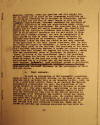
|
17.
25 January 1933.
Report on the 1932 Nicaraguan Elections,
Admiral C. H.
Woodward, Chairman of the US
Electoral Mission to Nicaragua, p. 17.
" . . . Sandoval,
however, found his gasoline and food
supply too low to permit him to carry on
his propaganda activities on the
following Wednesday so he returned to
Bluefields. Realizing he could not
get back to Pearl Lagoon in time for the
Wednesday registrations, Sandoval
persuaded the president of the local
directorio to keep his registration
books closed on the second day of
registration. The president was a
Sandoval Liberal and no doubt was easily
persuaded. The Conservative
members of the directorio protected this
action in a letter sent to me by special
messenger who did not arrive in
Bluefields until Tuesday evening, too
late to communicate with Pearl Lagoon in
time to order the electoral officials to
continue registrations on Wednesday.
Senator Sandoval was interviewed within
the hour and stated that he only
remarked to the president of the Pearl
Lagoon directorio that “he himself could
not appear on Wednesday”, a point of
view not held by any other party to the
incident. The president of the
directorio admitted receiving Sandoval’s
orders but claimed he accepted them only
because the Senator had given them as
coming from the Departmental Board of
Elections. On Thursday I removed,
by action of the Departmental Board, the
president at Pearl Lagoon for failure to
carry out his written instructions in
regard to the days and hours of legal
registration and released him by a
Liberal who did not belong to the
Sandoval faction. Thereafter, both
political juntas in Bluefields [?]
interfere with electoral personnel in
the performance of their official
duties. ¶ 6. Final comments. ¶
To seek an explanation of the successful
accomplishments of the U.S. Electoral
Mission, in the face of the
apprehensions which certainly were in
our thoughts in July, 1932, is to me a
profitless pursuit. There is no
question the Mission successfully
accomplished its task. The
cooperation of the Second Brigade of
Marines and the Guardia Nacional de
Nicaragua was, in a very great measure,
contributory to the satisfactory results
obtained. Too much emphasis cannot
be laid upon the particularly fine work
of the Guardia Nacional in maintaining
order throughout the republic during the
entire electoral period. In the
Eastern Area, the regular Guardia
garrisons were augmented temporarily by
a group of selected men who, in most
part, were ex-noncommissioned officers
of the Guardia with good character
discharges. These men enlisted as
privates and rendered excellent service
until re- . . . "
|
|
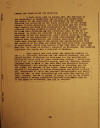
|
18.
25 January 1933.
Report on the 1932 Nicaraguan Elections,
Admiral C. H.
Woodward, Chairman of the US
Electoral Mission to Nicaragua, p. 18. "
. . . -leased two weeks after the
election. ¶ I feel quite
safe in saying that the election in the
Department of Bluefields was as fair and
represented the wishes of the electorate
as faithfully as any recent election for
president in the rural districts of the
United States, without exception, the
registrations and the voting were
orderly and free from intimidation or
coercion. No election official
grossly violated the trust reposed in
him. No votes were protested in
any directorio and, so far as I am
aware, no voter was deprived of his
right to vote for the candidate of his
own selection. About twenty
thousand votes were cast in the
department of which approximately forty
seven hundred were Conservative.
All Liberal candidates on the East Coast
were elected except the deputy and
deputy-suplente from the district of San
Juan del Norte who lost from their
opponents by eight votes. About
four hundred votes cast in this, the
smallest (in point of voting), district
in Nicaragua. The defeated
candidate for deputy was a resident of
Granada. ¶ Much credit has
been given the American members of the
U.S. electoral Mission and the Guardia
Nacional, and the Second Brigade of
Marines in Nicaragua for the
satisfactory results of their work in
their respective fields. I think
this credit is, in a considerable
degree, merited. However,
acknowledgement must be made of the fact
that the Electoral Mission was
successful, not chiefly on account of
ourselves and our own plans, but because
of the loyal, honest and unwavering
support of thousands of native
Nicaraguans who served without pay,
oftentimes at their own personal
inconvenience and sacrifice and who, in
this disinterred and patriotic service
for their country, led me to wonder if
there is not in the Nicaraguan people a
better foundation for self-government
than we, in our supervisor attitudes,
are apt to suspect."
|
|
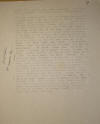
|
25 January
1933.
Letter from H. D.
Scott, Manager, Bragmans Bluff,
Puerto Cabezas, to Capt. Ernesto
Matamoros, GN, Puerto Cabezas
(Research notes of David C. Brooks, ca.
1990).
"Enclosure has a report from two spies
of the company on banditry up the Wanks
river. Report is entitled, "Jakal
Centro Enero 24, 1933." Spy is
said to have arrived at Moss Farm the
night before. Report is directed
at Mr. Weimer. Said he talked to
two men who had been captured by the
bandits and then escaped and came to
Saupuca where he met them and they told
him their experiences, "y dieran
noticias de los reeranos de más arriba,
esto es lo que me relataron: Las
cosas están malas arriba del río, los
bandidos están matando mucha gente
inocente, un tio de Bolsirpe (Fredricks)
quien trajó una carta para los bandidos
de la barra del Wanks, pidiéndoles que
salieran y fueran amigos, fue torturado
y decapitado y le dijeron que no
deseaban ser amigos de nadie. Los
bandidos asimismo reciberon una carta
del cuartel general del río y creemos
que sea de Sandino, pues dijeron y
protestaron que ellos no eran amigos de
Sandino ni de nadie más. Los
bandidos están estacionados en tres
lugares diferentes en el río y el Jefe
de ellos es Abraham Rivera. Su
cuartel general está en el campo más
allá arriba del río y era esperado en el
lugar donde estuvimos el día que nos
escapamos. El desea capturar el
bote de la fruta y merodear en las
propiedades de la Compañía. Hay
diez españoles, diez rifles, muy pocas
municiones y muchos indios con machetes
en el campo donde estuvimos prisoneros
pero no sabemos cuantos hombres y armas
tiene Rivera. Los bandidos matan a
todo el que pueden capturar y si no son
detenidos pronto ventrán a la línea."
Another report from Sapuca, 1/22/1933.
Bandits are in "Crin Crin ... Rivera
está más arriba del río, cuantos hombres
tiene el no lo sabemos, pero se le
espera abajo en el río diario, mataron
uno de mis tios hace pocos días.
Los hombres que se escaparon deseñar a
la Guardia Nacional donde campamos los
bandidos."
|
|
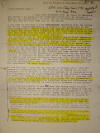
|
30 May 1933.
Letter from
Bishop Guido Grossman, Cabo
Gracias a Dios, to Dr. S. H. Gapp,
Moravian Church, Bethlehem PA, p. 1.
"Dear Brother
Gapp-: ¶ I just have
returned from my visit to Honduras, and
before I am going up the Wangkriver,
which will be perhaps tonight, I say
perhaps, for I am here really in the
“manana” country where one only can get
“tal vez” out of the people. ¶
I had here at the Cape a long interview
with the Governor of the comarca.
Especially in regard to our going back
to the upper Wangkriver. Whilst
Sandino has invited the merchants to
come up again and extend their
negotiation into that region again, he
has also sent words time and again that
he does not want us, that means the
Moravian Missionaries in that district.
¶ The Governor told me that
General Sandino has no right whatsoever
to issue such a decree, as the
constitution of Nicaragua stands for
religious liberty. But at the same
time, as the attitude of Sandino and his
men is such, the Governor advised me not
to go beyond the guard of the National
Guard, which is at Kisalaya, just above
Bilwas Karma. He has all hopes
that he, the Governor, will soon be able
to place his own officials in the
territory which now is claimed by
Sandino. In fact he told me that
Sandino has been ordered already by the
President of the Republic, to withdraw
all his men from that district to Bocay.
So he said: wait still a few months and
all will be right, I will have my
officials there and will have the whole
district under my control. He was
very nice and sympathized deeply with
us, especially over the murdering of
Bro. Bregenzer, whom he had considered
“un amigo especial”. ¶ At
the Bar here I also met an official of
Sandino and I took the chance to
interview him. He was reserved yet
polite as all the Spaniards are by
nature. I asked his opinion of my
intention to visit Sangsangta and the
upper Wangksriver. He was somewhat
reluctant to answer and finally he said,
that he had no right to pass any
official opinion, but he would advise me
at least for the present not to come
into the region, but he hopes that after
all differences with the government are
settled we would not be molested in the
future. ¶ I took the liberty
to ask him, what the reason might be,
that General Sandino was so much against
us, he ought to realize that we have
been a great help to the people on the
Wangksriver. He realized this and
told me that also Sandino knows this,
but as far as he could speak he said
there are two main reasons, that he
Sandino is against us: ¶ 1.
That the American officers and soldier
made the mission house, especially in
Sangsangia their home, thereby we showed
that we sympathized with them.
Also we lent them our boats so that they
could move about. We should have
known that Sandino’s feeling was bitter
against the Americans, because their
interference was unjust. ¶
2. That Sandino thinks, and he has heard
so, that we have extracted money from
the Indians, and sent it to the States.
¶ Of course, this is nonsense and
[?] it was published so in a Bluefields
paper last year, during my furlough and
no doubt such publicity has given
Sandino the idea, he believes it and
thinks now he is doing the right thing
to oppose us. . . . "
|
|
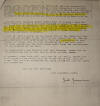
|
30 May 1933.
Letter from
Bishop Guido Grossman, Cabo
Gracias a Dios, to Dr. S. H. Gapp,
Moravian Church, Bethlehem PA, p. 2.
" . . . Finally
after I had given him my viewpoint and
also contradicted the false idea of the
money sending to the States, that is
just the contrary, that we bring so many
thousand dollars into Nicaragua he
changed his attitude. I asked him
the whether he thought General Sandino
would accept an explanation from me by
letter, I would be willing to write him
a letter, he said it would do no harm to
do so. ¶ I am now still
fighting within myself what to do.
When I read the daily texts of the day,
I am almost ashamed of myself to say I
cannot go? There are the
merchants, they are going there, carry
their goods, yea even their whisky etc
up among the people, and we, the
servants of the Almighty, we shrink back
and listen to human threats. It is
very very difficult to decide. ¶
I have met here a number of our people
from up the river, they were very glad,
and strange to say they too all agreed
that the time had not come as yet for us
going up there and reorganize our work
again. So taking this all into
consideration I may wait until the upper
Wangksriver has been placed again under
the jurisdiction of the Governor at the
Cape. ¶ The Danneberger’s
and Stortz’s left last Thursday the 25th
for the States and are by this time no
doubt in their homes. ¶ At
present things look still very dark in
the world, I wonder what will happen to
the dollar still, as to whether he will
still go lower. May the Lord
strengthen our faith in HIM who will not
leave nor forsake us. ¶ With
my best greetings ¶ Very
sincerely yours, . . . "
|
|

|
8 June 1933.
Letter from US
Vice Consul Eli Taylor, Puerto
Cabezas, to US Minister Matthew Hanna,
Managua. (Research notes of David
C. Brooks)
"Relates story
from the Fagots about their property
loss and their inquiry about what will
be done to get it back. Then also says
same happened to Moravians. "... I have
been informed by the Moravian
missionaries that their church property
at Waspook has also been taken away from
them by Sandinistas, who warned them not
to return to territory about Waspook.
Bishop Grossman of the Moravian Church
is now in Cabo Gracias a Dios and has
promised to give me a report of the
situation in that district when he
returns to Puerto Cabezas." Where is
this report? ..."
|
|
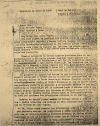
|
24 June 1933.
Letter from A. C.
Sandino, Wiwilí, to Juan Alberto
Fagot, Cabo Gracias a Dios, p. 1.
"xxx"
|
|
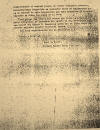
|
24 June 1933.
Letter from A. C.
Sandino, Wiwilí, to Juan Alberto
Fagot, Cabo Gracias a Dios, p. 1.
"xxx"
|
|
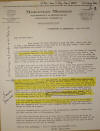
|
27 June
1933.
Letter from
Bishop Guido Grossman, Puerto
Cabezas, to Dr. S. H. Gapp, Moravian
Church, Bethlehem PA.
"Dear
Brother Gapp:- ¶ Many thanks
for your letters of June the 13th. which
came just to hand a few minutes ago.
As I have just to get the mail ready I
will right away acknowledge the receipt
of them. ¶ I am especially
thankful for the rules and regulations
for the Board of Trustees for the
Proposed Hospital in Nicaragua. It
is most important that such a new work
from its very beginning has a clear and
definite policy as well as rules and
regulation. This makes it for us
on the P.B. more easy for we know where
we stand and a proper relation between
the Board and the medical missionary is
established. Again I beg to thank you
and the esteemed Board very much for
this proceedings. ¶ I
returned back from my trip on the 15th.
of June. I was very glad to be
home again, as the rainy season is just
going to set in. It is not very pleasant
to be out at such a time. My
various letters you have received no
doubt which I wrote from the Cape.
The official report of the second part
of my journey I will write with the next
mail, as I had so many things to attend
also in the congregation, I have not
been able to do so, as yet. ¶
I just received a letter from the
official of Sandino with whom I had an
interview at the Cape. He wishes
to inform me that Sandino will not
return back into the Sangsangta
district, that every thing is quiet and
that the people are looking forward to
see me. Well this cannot be done
until November, but then I will pay a
visit into that district. In the mean
time I have asked Leopold Omier to pay a
visit to the Sangsangta district as he
is from up there and then give me a
proper report about conditions. He
speaks well Spanish and I have also
asked him to find out the sentiment of
the Spanish element, and now I am
looking forward for his report. ¶
I am also looking forward for the
Haglunds, it is very hard for me to know
that the whole Wangkriver is without a
Missionary. It is such an
important work and therefore will be
very much relieved when the Haglunds
have taken charge of their work again.
¶ Otherwise everything is quiet,
only the unemployment question becomes
more and more serious here in Nicaragua,
as well. ¶ I hope that the
dollar does not go down more, I suffer
much, as we lose on every draft which we
have to send to Germany for our
children. We have to cut down our
expenses to the mere existing point.
But we know the Lord is still alive,
therefore we will not be afraid. ¶
With my best greetings. I beg to
remain very sincerely yours, . . . "
|
|
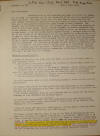
|
1.
31 July 1933.
Circular No. 138,
Bishop Guido Grossman, Bilwi, to
his "Dear Coworkers," p. 1.
"Dear Coworkers:-
¶ Sometimes even an old acetylene
gas plant can teach us a lesson for the
day: We installed one for our
church, but it did not work properly,
something was wrong. The lights
burnt dim. Now last week we found
out that the tank needed a little more
pressure. So we put something
heavy on the top of the tank and to our
greatest delight the light started to
burn brightly. The thought came to
me: God thought that His children
need a little more pressure in order to
have their lights shine a little
brighter. He permits therefore
that we are pressed by
inflation-depression-shortness of money
and workers to give us more power to let
our lights shine brighter through a
stronger faith in HIM, who in the Master
of the vineyard, and who not only knows
our needs, but who is also able to meet
all our needs. He put a little
more pressure on us to have more power
to decrease of self, so that he might
have in all things the preeminence!
He put a little pressure upon us, that
we may hear the Lord also speak to us:
"My grace is sufficient for thee, for my
strength is made perfect in weakness."
The also to be able to say with Paul:
"I rather glory in my infirmities that
the power of Christ may rest upon me."
"Therefore I take pleasure in
infirmities in reproaches, in
necessities, in persecution, in distress
for Christ’s sake for when I am weak
then am I strong." ¶
Official communication: ¶ A
letter of Bro. S. H. Gapp dated June the
14th. conveys the following news to the
Provincial Board: ¶ 1. "The
directors are glad to ratify the
election of Brother Rufus Bishop as
member of the Provincial Board. ¶
2. Great interest was shown in the plan
of beginning a native Indian Ministry.
It meets with our entire approval.
Circumstances seem to be forcing us more
into dependence on native help, but the
thing is right in principle. ¶
3. On Dr. Theeler’s suggestion a special
Board of Trustees is to be appointed for
the proposed Hospital in Nicaragua.
¶ You will hear more later on your
conference, especially after we have
received the minutes." ¶ "We
rejoice with you at the fine spirit that
was manifested at the conference and
feel sure the blessing of our Lord will
rest upon your very important
discussions and decisions." ¶
"With kindest greetings from all the
Directors and the prayer for the Lord’s
blessing in your difficult but glorious
work." ¶ The Bluefields
congregation and Rama Congregation have
made through their Pastor Bro. K.
Hamilton formal application to have a
seat in the District Conference, when it
is convened. ¶ I have not
heard anything from Pearl Lagoon.
I would like to have the first district
Conference before the year 1933 closes.
¶ The Super. visited from the
14th. of May to the 15th of June:
Kaurlirain Honduras and the lower and
middle Wangksriver. Br. A.
Kreitlow accompanied me as far as Kruta.
She took charge again of her work there
in Wabamlayu. It was really a joy
to see how glad the people were to have
her back again in her work. How
willingly they were carrying all her
belonging from Kruta to Nahamlaya.
In a couple hours all her belonging were
in her house. By now I hope that
her house is finished and she is well
settled, and I think by the experiences
which she had in building her house, she
has become quite a carpenter herself! .
. . "
|
|
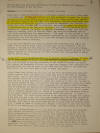
|
2.
31 July 1933.
Circular No. 138,
Bishop Guido Grossman, Bilwi, to
his "Dear Coworkers," p. 2.
" . . . The new
place has been well selected, and we
wish our Sister much blessing – joy and
happiness in her new home. ¶
Reports: of my traveling which are of
general interest. ¶ Happy
days I spent in Kaukira. What a
difference between now and my last visit
a few years ago. At that time we
were not even permitted to preach the
Gospel, and now we have a home here, a
church and the first fruits of our dear
Brother and Sister’s labour. I was
saluted by the Honduranian National
Anthem, well sung by the school
children. The progress in school
is remarkable. The services on
Sunday were well attended and the
attention was good. The hymns are
announced in Spanish, as well as the
Scripture lessons. A very good and
practical way of teaching and learning
the people to express themselves in that
what they have heard in a meeting, which
is held on Friday, in which the
believers have to tell Bible stories,
which they have heard. The spot of
our station is also well chosen and the
buildings conveniently arranged. Bro.
and Sr. Heath need our prayers, that the
Lord may continue to give them strength
and health to continue their Master’s
work in Honduras. ¶ On my
way back services were held in
Yamanta-Wahamlaya-Raya Bank and at the
Port. I was unable to visit Irlaya
and Old Cape. To save expenses I
was depending on the gasoline boat going
up the river, although I had made
arrangements with Pedro to visit the Old
Cape, yet the Captain changed his mind
and left Tuesday instead of Wednesday,
and so I had to leave with them instead
of going over to the Old Cape. ¶
At the Port I had an interview with one
of General Sandino’s Officers. He
advised to wait a while yet before going
up into the Sangsanta district. He
did also the Governour at the Cape.
According to his advice we should wait
until the Waspuck and Sangsanta district
has again been staffed with Government
officials, which shall soon be done.
At the same time the water in the river
was very low, so the boat could not go
even to reach Wira pani. ¶
Bilwas Karma here Dannery and his wife
are one with the people. They have
suffered together well. The people
are still very poor in the line of
clothes, some really came in just but
rags, others I saw in tunu. In the
food line they are somewhat better now
as they have plantain and bananas coming
in now. Also they are able to sell
bananas and I think in a month or so
they will be able to buy better clothes
as well. The services were well
attended. On Sunday the church was
full, there were between 4-500 people.
At the H.C. we had about 300.
There were 59 candidates for Baptism and
confirmation. But only 22
candidates could be added to the
congregation. Four by baptism and
18 by confirmation. Of the others
some of them were away, and did not
return in time. Others had
absolutely nothing to put on and in
spite of urging they said: we would feel
ashamed to appear in the Lord house with
these rags; a few had to be postponed &
couples were married. I met here
also not a few from the upper
Wangksriver. A few of them partook
the H.C. The people in the
Sangsangta district are waiting for us.
It had been reported that some of our
people had made common cause with the
bandits. Especially I heard from
Pedro of Sangsangta a helper. I
was glad to hear from him, that he did
it not heartily, as he said, he was
forced into the service of the Bandit.
¶ Wasla was a disappointment to
me. They have not stood the test
very well. Heathen practice and
stealing have weakened not a few.
As also in Kumyea the whole
neighbourhood. I do not think it
has been Leopold’s fault. As I put
the question before the helpers about
Leopold, they said: he has done well to
admonish us and we dare not blame
anybody else, except our own self."
The confession gives me hope that after
the whole trouble of the banditry and
famine is over, they may respect and be
newly inspired to walk in His ways.
It was a great test for them indeed. We
have to admit that and just at such a
trying time they were without a
missionary. At the H.C. I had only
53. . . . "
|
|
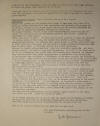
|
3.
31 July 1933.
Circular No. 138,
Bishop Guido Grossman, Bilwi, to
his "Dear Coworkers," p. 3.
" . . . Anris too
is very backward, I could not keep H.S.
But we had very nice services at Boom.
The people there appreciated my visit.
¶ There was plenty of medical work
to be done. I gave to over three
hundred children Worm medicine. A
most splendid opportunity train ones
self to become a prize fighter! ¶
Congressional Reports: Only
Bluefields has sent in a report. ¶
Bluefields: ¶ Despite the
poverty of our people, which tends to
keep some away from God’s house, our
Sunday services have been remarkable
well attended. The average for the
morning service in the three months was
393, in the evening 483. These
figures do not include the special
services of "Rally Day." ¶
"On Maundy Thursday we met at the Lord’s
table. Counting those who had
received sick communion the day before,
423 partook. The largest number in
Bluefields for eight years. ¶
During the season of Lent we were able
to hold a number of open air services in
various parts of the town. The
Church Band provide a great help on
these occasions, beautifying the
services and leading many to attend, who
would hardly otherwise have come.
Again the Lord gave us large number,
including many whom we never reach by
services held in the church buildings.
¶ Further the weekly cottage
meetings have been conducted regularly,
and have brought comfort and help to may
shut in members. As fruit of the
work, such as can be tabulated, we can
report that five members were received
in Preparatory service, either from
other congregations or readmitted from
discipline; 18 new members were
confirmed on Palm Sunday and 20 others
applied for membership since Easter
(later news from Bro. Hamilton stated
that 31 have made application). We
are specially happy by the large
proportion of young people represented
in these numbers. Among those who
went to their eternal rest was the
oldest member of the congregation, Sr.
Sarah Hodgson, aged 104. No less
than 161 descendants survived her."
¶ Our Sunday School has been
especially encouraging. "The
average attendance in three schools for
the first quarter of the year was 780.
After Easter we held a contest between
the three schools to see which could
increase its attendance most. As a
result, during April and May we had an
average of 1147 present, each Sunday.
On the 1st Sunday in May we held our
‘Rally Day", when 2105 people attended
the three schools. That is the
largest proportion of the total
population of Bluefields! On that
morning we conducted a union service of
praise for the three schools. No
building could hold the number of
people, we met in the open, just south
of the Central Church. The space
between the Church and Mr. Smith’s shoe
making establishment was packed with
people. It was an inspiring
occasion." ¶ Old Bank won
the prize. Central had the highest
number present on the Rally Day itself
and thus chose the Rally Day queen."
¶ It is indeed inspiring for us
all to read the report of Bluefields.
And indeed we thank the Lord with our
Bluefields congregation and take new
courage. How about Rally days in
other congregations? Let us hear
about it! ¶ For today I have
to close, bring me news for the next
one! ¶ With very fraternally
greetings, yours in His service: ¶
/s/ Guido Grossman"
|
|
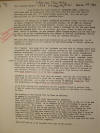
|
1.
4 October 1933.
Letter from
Bishop Guido Grossman, Bilwi, to
C. Conrad Shrimer, Bluefields, p. 1.
"Dear
Brother Shiner: ¶ Many
thanks for your letter of September
20th. Sorry the mail came into my
hands, just after the Ultra –Mar had
left the Port, if one does not look out
for those things personally one does not
get the mail, but all that takes away
precious time. ¶ Indeed we
are living in an extra ordinary
difficult times and they cause us extra
ordinary worries and sleepless nights.
One plans and replans how the province
can be satisfactorily manned and yet one
comes to no satisfactory solution.
My last plan which I conveyed to you was
sent forth with the sincere hope that a
solution had been found to keep the
present staff of workers on the present
15000 budget, especially for the sake of
the work on the Wangksriver, by the
return of Bro. and Sr. Haglund.
But it met with disappointment. We
have to seek for another solution.
¶ The plan you propose in your
last letter is in so far acceptable as
it permits us to keep Bro. and Sr. Heath
in the field, which is indeed quite an
important matter. ¶ Yet I
regret very much that the Haglunds are
not able to return under your plan,
which you suggested. This puts the
problem of the Wangksriver in a very
serious condition. It is quite
impossible to leave the whole
Wangksriver district with one ordained
man, that means Hannery – but and I
emphasize my statement: we dare not
leave the Wangksriver any longer
exposed, something must be done.
Your suggestion to put Coleman, Jack as
school master to Bilwi just tells me,
that you do not really understand the
whole seriousness of the condition in
which we are from a missionary point of
view. Otherwise you could not make
such a suggestion to put a man, who can
do missionary work, into the school
work, which has been closed on account
of the financial reasons. By no
means can we spare Jack Coleman for
school work. Jack Coleman has to go to
the Wangksriver. ¶ Therefore
in view of the fact that we cannot ask
Bro. and Sr. Haglund to come back to the
field, at least not at present, I ask
that Jack Coleman shall be ordained and
called to take charge of Sangsanta with
the supervision of Musawas? This
is absolutely necessary! ¶
As we have already the permission of our
superior Board to ordain Jack, I wish to
ordain him together with Dannery Downs
on the 29th. of October, in Yulu.
¶ The manning of the field will be
then as follows: ¶ No change
in Bluefields: ¶ Pearl
Lagoon has to look after the Karawala
district. ¶ What will become
of the middle district I do not know as
yet, as I have not heard of Br. Newton
Wilson as to whether he will be willing
to serve the whole district that means:
Quamwatla and Haulover district with the
sacraments, as he it put on the pension
list. In case he refuses to look at
least over the Haulover district, that
he only will take care of his Quamwatla
district, then there will be no other
way then that I have to take that
district under my care. In that
case Bro. Bishop will have to be asked
to take care of the Cape in regard of
serving the sacraments. Palmer is out of
question, it is my conviction that he
not even will be able to look after Yulu
district properly. ¶ Yulu
will remain as it is, under the Care of
Bro. Palmer. . . . "
|
|
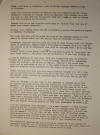
|
2.
4 October 1933.
Letter from
Bishop Guido Grossman, Bilwi, to
C. Conrad Shrimer, Bluefields, p. 2.
" . . . Bilwi
will have an additional work of either
looking after the Cape or Haulover.
¶ Sandy Bay will have Dakura and
perhaps the Cape District, if Bro.
Wilson refuses to continue to assist.
The Cape District will include only the
Old Cape and the Port and Irlaya. Raya
Bnk and Halmalaya will be served with
the sacraments by Bro. Heath. ¶
Rinkerd will be at the Cape. The
ordination of Rinkard will also one of
these days become necessary. ¶
Kaurkira will remain under Bro. and Sr.
Heath’s care, for the north we cannot do
anything at present. ¶ The
Wasla District will be under the care of
Bro. Dannery Downs. He will remain
in Bilwas Karza and Leop Miller will be
stationed at Wasla. ¶
Sangasanta district will be under the
care of Jack Coleman with the Leopold
Omier as assistant. Perhaps when I
have been is Musawas we may be able to
ask Leopold to go to Musawas, but this
will be arranged when I go to see the
district. ¶ Leopold Omier I
have given order when he was here to
move to Sangasanta and stay there until
I come. This will be in November
if the Lord permits it. ¶ I
beg to emphasize it once more, that the
Wangksriver must be properly manned and
I cannot see that it can be manned
better than suggested, since the
Haglunds are unable to return.
This: that the newer work shall not be
neglected on behalf of the older work is
also in accordance with our superior
Board, according to the Letter of Dr.
Gapp. ¶ Please realize that
this plea has been carefully thought out
and I also can say prayerfully. I
do think that it is the only way how we
can under the present extra ordinary
circumstances do better, so let us put
the plan into effect. ¶
About Dr. Thaeler I do not wish to say
anything at present as we have to
discuss the whole matter with him
personally after his return from
Managua. To keep him in Bluefields
I cannot see the need of it at all.
It would be a thousand pity to have him
in Bluefields where they are already
more doctors than needed. They all
believe they are "good" Doctors.
He has to enter there into competition
with the rest of the doctors and his
success means to take the bread away
from the others. This may be
alright from a business point of view,
but whether from a racial and political
point of view be wise and help our
mission. I doubt very very much,
as you know the slogan "Nicaragua first"
is very much promoted in these days.
¶ I do not understand your
sentence: "we cannot pension a native
brother and have the full foreign
forces" where is the foreign force that
means the "full"? If conditions do not
improve very substantially – I cannot
see how the Storz’s can come back.
And a worker like Bro. Haglund comes
into consideration, we should not go so
easy about it. We have but few of
his type. We work for two indeed
if needs be for three. What he
does it well done. He would have
been the back bone of the Wangksriver
work. ¶ The Palmer had
accepted the call, we have to accept it
on the ground of charity – I think we
are all convinced that he cannot do the
work. This will be again another
burden to me, having him so close at
hand. . . . "
|
|

|
3.
4 October 1933.
Letter from
Bishop Guido Grossman, Bilwi, to
C. Conrad Shrimer, Bluefields, p. 3.
"… But I do ask
you dear Brother Shimer give him
thorough instruction about his financial
affairs and do not make me responsible
for his financial transactions. ¶
I would suggest the following. ¶
1. Palmer should not receive a check
book. And please tell him that his
checks signed will not be accepted.
¶ 2. Ask him how much he will need
for his children in Bluefields and that
amount will be taken off from his
monthly salary. The Children will
have no credit in Bluefields, like in
former years where they just could go
and buy what they wanted. ¶
He has to send to me every end of the
month a statement what he has taken in
on cong. cash and collection set.
This then will be deducted from his
check which I will give him every month.
¶ 4. He shall have no open credit
in Bilwi, if he buys at Pattersen in
Yulu, Pattersen has to send a monthly
statement to me so that this amount too
[illegible] please write to [illegible]
Commissary and Bilway Trading Company,
but Pattersen I wish that you write to
him. ¶ Tell him if he again
enters into debts, he will then be put
on the pension list. He has drawn
the highest salary of the whole mission
staff, and it is time that he looks very
carefully into his business affairs.
¶ With fraternal greeings, ¶
Guido Grossman"
|
|
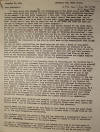
|
7 November
1933.
Circular No. 140,
Bishop Guido Grossman, Bilwi, to
his "Dear Coworkers," p. 1.
"Dear Coworkers:-
¶ If Jesus would have thought as
we are thinking, and if His faith would
have been like ours is, He would have
said to the poor hungry multitude which
confronted him, there in the desert:
I am very sorry indeed, but I have only
five loaves of Bread and two fishes
here, therefore 4990 of you have to go
home, I cannot feed more than ten of
you, with that what I have in my hand.
But, yes but, Jesus knew his Father and
therefore he was able to say: Not:
go away- no- but to sit down- and they
sat down and not one of them, got up
again from its place- hungry!!!- ¶
The last weeks I had many a sleepless
night. Only 15,000 dollars we can
have! Shall we now say to the poor
hungry souls in Sangsangta and its
district at Musawas and in the Brus
district we cannot feed you- we must
leave you alone? If we would say
and act like that, surely we would not
deserve the name of "Moravian
Missionaries". Also I am sure God
would be well displeased with us.
Now we dare not say so- we dare not send
them away- if we claim to know that we
have a God in heaven, whose servants we
are. No- let us venture to do what God
bids us to do in Faith in the Almighty.
Then God will manifest His Grace, that
we can even do still more in His
vineyard, with even still less money!!!-
¶ Yes days of great perplexities
are these days, and yet when I think of
Yulu, where Dannery Downs was ordained
October 29th, how God manifested His
presence to us and when I still remember
these splendid, yas powerful addresses
given by some of our Evangelists and
Helpers, who had come to Yulu, then I
thank the Lord and take courage. A
work of God, which has produced such
men, who stand steadfast and firm on the
main point of our Christian Doctrine:
Jesus Christ the crucified risen and
highly exalted Savior, cannot go to
pieces, on account of lack of
funds!!!!!!- ¶ According to
the decision of our Directing Board in
Bethlehem, and the decision has been
very painful to our esteemed Board of
Directors, they only can allow us, on
account of the extreme difficult
financial situation of our Home Province
15,000 for the annual budget, 6,000
dollars less than last year. In spite of
the reducing our salaries another 10% we
could not make both ends meet.
Finally we had to come to the very very
sad conclusion to cut our forces still
more. With great sorrow we had to
ask our Brother Newton Wilson to go on
the pension list and that Bro. and Sr.
Haglund should stay in their Home
province, in order to keep within the
allowance of the budget. We do
hope that this is only temporarily.
Bro. Newton Wilson is still willing to
serve his district as hitherto, and we
are indeed very thankful to our Brother
for this great sacrifice. Also
after a long correspondence with Bro.
and Sr. Haglund, they have declared
themselves willing- as they feel it is
God’s will to return to this field
again- to come out on pension salary,
until better days are coming again.
We hope they will soon come. We
too thank our Bro. and Sr. Haglund for
their willingness to serve still in the
field. It is to them not a small
sacrifice, which they bring.
Through their willingness we are now
able to have the middle coast and the
middle Wangksriver district properly
served, which is a great relief to me
especially. ¶ Bro. and Sr.
Palmer have received and accepted a call
to Yulu, and will soon move there.
Karwala will be served for the time
being by Bro. Hedley Wilson from Pearl
Lagoon and Charley Moses will be
stationed at Karawala to serve that
district. ¶ Leopold Omier
has been asked to go from Wasla to San
Carlos to serve the upper Wangksriver
District. Further arrangements will have
to be made after I return from my visit
to the upper Wangksriver and Musawas.
¶ Bro. G. R. Heath visited the
people at Brus and has organized a
congregation there. I gave Dannery
Downs instruction to go after the Week
of Prayer to Brus to administer the Holy
Sacraments to the people there. ¶
Bro. and Sr. O Danneberger are in
England and Germany. They hope to
be back again in the States by
Christmas. They sent their
greetings to us all. Also Bro. and Sr.
Stortz send greetings. Bro. Stortz
is busy to advocate for our work and we
are glad to hear . . . "
|
|
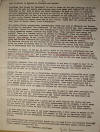
|
7 November
1933.
Circular No. 140,
Bishop Guido Grossman, Bilwi, to
his "Dear Coworkers," p. 2.
". . . that Sr.
Stortz is gaining in strength and
health. ¶ Greetings from Br.
And Sr. Schubert. "We beg to thank
you for the greetings which you sent us.
You made our hearts glad, because your
kind words tell us that we are not
forgotten in the work to which our heart
belongs.- We know the time of
conference and have remembered you
whilst you were on the way to Bilwi, and
while you were in session. Reports
tell us that you felt the presence of
the Lord. That you have decided to
make a step forward towards the Native
Church is enough to gladden our hearts.-
Build on Christ the cornerstone and he
will surely bless what his servants are
doing. Your in Christ Jesus. L.
and H. Schubert." ¶ Bro.
Newton Wilson reports very interestingly
about his trip to Ebenezer and Wasakin.
He writes for instance: "The
attendance at the Public service was
most pleasing and a happy occasion; more
so because the first fruit from
Clarendon were among the number."
There is a "marked spirit of revival in
Ebenezer". Since the movement in
Clarendon, negligent ones have been
aroused. Also in Wasakin our
Brother could baptize five adults.
He was pleased with the Sunday school
which is conducted by a young man:
Ephraim Francisco. The influenza
has been raging among the people.
The Haulover district too was visited by
our Brother as you know, he serves that
district too since Bro. Fisher went to
the Yulu district. The report from that
district too is encouraging with the
exception of Kukalaya, the people are
very careless. ¶ Bro. Fisher is still on
the go. He paid a visit to the various
stations. He has instruction for
confirmation everywhere. In Tuberus he
could baptize 5 adults and readmit 9
persons. Sept. 24 "was a great day in
Kalilakangban, were the Tuberus people
are still living at present. Bro. Fisher
will still help us out for some times
for which we are very thankful. ¶
Bro. Bishop complains "that the church
attendance is not what it ought to be."
It is chiefly due to the plantation work
up the river and also due to improper
clothing, as every penny goes for food.
Their choir is encouraging, also the
school work in Sandy Bay as well as in
Baymuna and Dakura. ¶
October 15 was a great day in
Bluefields. Brother K. Hamilton
writes: "We could confirm 37,
baptize one adult and receive another,
who had been instructed with the rest,
but had been confirmed in the Catholic
church a few years ago. It was a
happy service for me, though it was
interrupted in a strange and saddening
way, by the death of one of our members.
Sr. Eleana Hooker, originally from Grant
Cayman. She has a heart attack
while in the congregation, and died on
the church steps. It was an occurrence
which could not but impress all who were
present." ¶ Bro. G. R. Heath
writes from Kaurkira: "you will be
glad to hear that yesterday Oct. 22nd,
we had the joy of baptizing four women
from here, with the four children of one
of them, and also two schoolboys and one
school girl, who had made their own
application and were therefore admitted
as adults. ¶ In Bilwi we had
last Sunday also a great day we could
baptize two adults and confirm 5 and one
was readmitted. At the Holy
Communion we had 65 present. I
still remember the first H.C. six years
ago, when only 8 were present. We
have three Sunday Schools now and last
Sunday we have over 200 children present
in the three schools. ¶ I am
just ready for the visit to the upper
Wangksriver. I will leave tomorrow
if the Lord permits and will be away
about five weeks. It will be an
important visit indeed to rearrange and
reorganize the work in Sangsangta and
Musawas. Please pray for me. ¶
Soon after Easter the first District
Synod will be held D.V. of the Southern
District. More particulars will be
given later. Bluefields-Rama Key-Pearl
Lagoon-Tasba pouni please prepare
yourself for it. ¶ With
fraternal greetings, ¶ Guido Grossman"
|
|
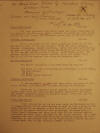
|
1.
12 December 1933.
Monograph of
Nicaragua. US Marine Corps
Intelligence Division (with sections on
Atlantic Coast), p. 1.
[Note that
some of these data apply to Nicaragua as
a whole] "SOCIAL CONDITIONS
¶ 200 ¶
TOTAL POPULATION
202-100: ¶ The best
available statistics place the total
population of Nicaragua at 638,000 (year
1926). However, no census has been
taken within the last decade and
estimates run as high as 900,000 souls.
¶ DENSITY,
POPULATION 202-200: ¶
About one fourth of the total population
lives in the six important towns, in the
lake plains. These are Leon,
Managua, Grandaa, Chinandega, Masaya and
Rivas. About one half lives within
an area of 4,000 square miles along the
Pacific coast and about 32% in the
uplands within an area of about 6,000
square miles. The average density
for the entire republic is 13 per square
mile. Nearly all of the negroes
live along the Atlantic coast. ¶
NATIVE POPULATION
202-300: ¶ The native
population is divided about as follows:
¶ 17% white or with a
predominating percentage of white blood.
3% pure Indian. 9% Negro.
71% Mixed blood (Ladinos) ¶
FOREIGN
POPULATION: 202-400 ¶
It was estimated in 1928 that there
were, exclusive of military forces,
1,100 American citizens residing in
Nicaragua. ¶ There are no
estimates of the numbers of other
foreigners except that there are about
55,000 negroes employed by the fruit and
lumber companies along the Atlantic
coast. They are, for the most
part, British subjects. ¶
VITAL STATISTICS:
202-500 ¶ Vital statistics
as yet are very crude in Nicaragua and
are of comparatively little value except
as more or less a guide to the gross
mortality on account of the fact that at
least 90% of the people in the rural
districts have no medical attention even
in their final illnesses and quite more
than 50% are without medical attention
in their final illnesses in the larger
centers. As a consequence the
vital statistics which are collected
through the civil registers at the
present time are of little medical
import and give a very crude idea of the
principal causes of death."
|
|
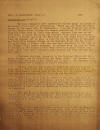
|
2.
12 December 1933.
Monograph of
Nicaragua. US Marine Corps
Intelligence Division (sections on
Atlantic Coast), p. 2.
"DEPARTMENT
OF BLUEFIELDS (Con't) / 600 ¶
Communications:
(Con’t.) ¶ Various companies
have constructed narrow gauge railroads
to facilitate their work of exportation.
There was one from the Pearl Lagoon to
the sugar mill at Huahuashau. A
second railroad ran along the Rio Grande
River through the banana plantations of
El Gallo along the right bank to first
deep water. Another line was on
the left bank. A third was long
the Cucalava River used for hauling
timber. A fourth was from the Eden
mine to the Tunky River, 5 miles long,
at present out of use. A road for
the extraction of mahogany was built
from Lehmans Bodega on the Kukalaya
River and ran along its north bank to
Siska. The last and most important
is the line of the Bragman Bluff Lumber
Company. It extends from its dock
at Puerto Cabezas up the valley of the
Wawa River to a point beyond Logtown.
This line taps a valuable pine country
and runs through banana lands. ¶
Wireless stations, operated by the
Tropical Radio and Telegraph Company,
are at Bluefields and Punta Gorda.
The Cuyamel Fruit Company have stations
at Rio Grande and El Gallo. The
Bragmans Bluff Lumber Company has a
station at Puerto Cabezas. ¶
In the interior the routes of
communications are long and wide apart.
The rivers are navigated with difficulty
by canoes. A trail from Puerto
Cabezas gone to San Luis, Pis Pis,
Siuna, Huani, Iyas and then branches off
the Jinotega and Matagalpa. ¶
There is a trail from San Pedro to
Matiguas, one from La Cruz to Santo
Domingo by Curinhuss. A trail from
Camoapa in Chontales has a branch down
the Curinhuas and one down the Siquia.
There are also said to be trails from
Santo Tomas, Acoyapa and La Manga in
Chontales. A trail runs from
Quadelupe to Morrito and san Miguelito
in Chontales. ¶ The new
Atlantic Highway has been constructed as
far as Muelle de los Bueyes, the
terminal. This latter is to give
truck transportation to Managua, from
Los Bueyes to Bluefields transportation
will be by water. ¶
Population:
¶ Inhabitants number 31,000, of
which 7,000 are Mosquito Indians.
This department has two municipalities,
Bluefields, the capital and El Rama.
There are also two police inspection
districts called Rio Grande and
Prinzapolka. For a description of towns
see Section 601 and 602."
|
|
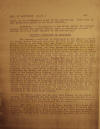
|
3.
12 December 1933.
Monograph of
Nicaragua. US Marine Corps
Intelligence Division (sections on
Atlantic Coast), p. 3.
"DEPARTMENT OF
BLUEFIELDS (Con't) 600 ¶ . .
. tower, on the southeastern point of
the western cay. This light is only
shown when needed by the fruit steamers.
¶ ANCHORAGE. – In addition to the
little harbor for fishing vessels
between the eastern islets, there is
anchorage in about 9 fathoms (16.6 m.)
close westward of the western cay.
¶ ECONOMIC
CONDITIONS IN BLUEFIELDS ¶
The economic conditions in Bluefields do
not improve, and if the banana market
does not show more activity in the
future the principal industry of the
East Coast may cease to exist – in both
Puerto Cabezas and Bluefields. The
United Fruit Company, operating in the
Southern half of this area, has been
gradually reducing their commissary
stocks and have turned over all outlying
commissaries to native contractors, who
are paying for their store stocks of
merchandise from monthly profits, on the
long term basis. With the
exception of the local Bluefields retail
store, the United Fruit merchandise
business is now mainly wholesale.
During 1931 its stock inventory has been
decreased from $230,000.00 to about
$40,000.00, in value. The
miniature cities, such as EL GALLO and
PUUTA GORDA, which a few years ago were
thriving population and fruit centers,
that required thousands of dollars for
the weekly payroll, and even maintained
local railways, are now practically
deserted. The dozens of
modern-built residences are vacant and
carry an official inventory value on the
books of the United Fruit Company, of
only $100 per house. The local
manager of the United Fruit Company
frankly states that extensive holdings
of banana lands in other countries is
more than sufficient to supply the
banana demand in the markets, and that
they will cease to operate in Nicaragua
if further taxes, imports and duties are
levied. The recent tax on
commercial paper, drafts and checks
conveying money from Nicaragua to the
United States, is seemingly, a grossly
exorbitant tax. If affects foreign
industries’ operating in Nicaragua to a
grievous degree, and in particularly
obnoxious to the local fruit company.
¶ The Mobile lumber men who have
been logging in the region between the
PRINZAPOLKA and RIO GRANDE exported some
250,000 feet of pine and hardwoods to
the United States for experimental
purposes. Their activities have
been suspended for the present. ¶
The large, retail, dry goods Jorge
Dreyfus & Co., store in Bluefields, is
closing out its business, and intends to
reopen in Managua. In common with
other stores they have been losing money
regularly, reducing stock to barest
necessities, and have finally decided to
accept their losses, and reopen in a
more favorable locality."
|
|

|
4.
12 December 1933.
Monograph of
Nicaragua. US Marine Corps
Intelligence Division (sections on
Atlantic Coast), p. 4.
"COMARCA
(TERRITORY) OF CABO GRACIAS A DIOS
(Con't). 600. ¶
Commerce
(con't): ¶ pine and bananas.
Manufactured articles are imported as is
some corn from the United States.
¶
Communications: ¶
There are cattle trails from the bank
for the Coco River and the Pis Pis mine
area to Puerto Cabezas. Nearly all
traffic is by means of boats. The
Coco River is open to power boats to
Andres the whole year round, smaller
power boats to Sang Sang: above this
point the river is open to canoes.
Rapids are numerous between Balana and
Bocay. Nearly all the affluents of
the Coco are navigable for canoes.
The lagoons and rivers that empty into
them are used by small power boats.
¶ The Tropical Radio Telegraph
Company has a radio stations at Cabo
Gracias. ¶
Population:
¶ This territory has 12,000
inhabitants, of which 10,000 are
Mosquito Indians. This population is
principally in two zones: One
along the Coco River with 79
settlements, the other about Sandy Bay.
There is no municipal division. ¶
Banditry:
¶ The principal bandit efforts
have been along the Coco River, and,
above all, in the valley of the Wawa
River."
|
|
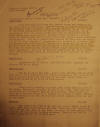
|
5.
12 December 1933.
Monograph of
Nicaragua. US Marine Corps
Intelligence Division (sections on
Atlantic Coast), p. 5.
"Cities &
Towns, Con't. ¶ (600
Section) ¶ PUERTO CABEZAS
¶ 601 ¶ Coordinates,
Marine Corps Map - 555-423. ¶
Importance
601-100 ¶ This and
Bluefields are the leading towns and
seaports on the east coast of Nicaragua.
Puerto Cabezas is almost entirely by the
Standard Fruit Company. This
company employs the greater part of the
town’s population in its fruit exporting
business. It is anticipated that
the banana farms will stay in production
for at least three more years and the
Standard Fruit Company at present plans
to operate here for at least three more
years before abandoning its holdings.
The large lumber mill located in this
town and operated by the same company is
inoperative due to lack of business.
It is expected that the town will shrink
to a small village of no importance when
the Standard Fruit Company ceases its
activities here. The town was
built by the Bragmans Bluff Lumber
Company to house their employees.
It is of no military importance nor
naval importance and is the most
northern settlement in the district of
Bluefields. ¶
Population
601-200: ¶ Approximately 50
and 1,000 natives. Germans and
Chinese are to be found. ¶
Hydrography
601-300 ¶ See H. O. Chart
No. 130. A new light flashing “B”
in Morse Code can be seen distinctly and
easily recognized. The town itself
can be located from long distance by the
smoke coming from the numerous stacks or
by glare of town lights. ¶
Anchorage
601-400 ¶ Usual naval
anchorage is about 1.000 yards from the
head of the dock. Commercial
steamers tie up to the dock. Wind
usually heavier in the afternoon than in
the forenoon. Open roadstand.
Deep draft vessels anchor 2 to 3 miles
to seaward of dock. Smaller
vessels drawing less than 20 feet may
anchor anywhere near the end of the
dock. ¶
Wharves
601-500: ¶ One wooden pier
800 yards long on which a double track
is held. This pier is in good
condition. There is a 12” water
line and a 7” oil pipe line on the dock.
The pier is also equipped with a crane
and four banana loading machines.
There is 22 feet of water alongside the
end of this pier."
|
|
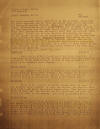
|
6.
12 December 1933.
Monograph of
Nicaragua. US Marine Corps
Intelligence Division (sections on
Atlantic Coast), p. 7.
"Cities & Towns,
Cont. (600 Section) Puerto
Cabezas, Cont., 601 601-2000 ¶
[Public Health
601-2000] . . . ago there were many
cases, believed to be due to flies.
Since then all white employees and all
first and second class native employees
are vaccinated against typhoid.
Small pox:
Sporadic cases may occur. Eighteen
months ago 5 cases (latter part of 1929)
of small pox were imported from the
Wanks (Coco) valley. Following
this, the whole local population was
vaccinated, about 6000 vaccinations
being performed. In addition to
this, Moravian missionaries vaccinate
all the Indian villages in the
neighborhood, about 2000 vaccinations
being performed by them.
Venereal diseases:
Practically all the prostitutes live in
Bilway, most of them are Indians, some
are of Spanish descent. There is
no Government supervision or segregation
and practically all are infected.
As a result, a large number of the white
employees of the company have been
infected with gonorrhea, syphilis and
chancroid . ¶
Resources
601-2100 ¶ There are no
natural resources of any great
importance in this locality, although
tropical fruits, cotton, maize and rice,
are available. A one month’s
supply of food is kept on hand at all
times by the Standard Fruit Company.
¶ Public
Works 601-2200 ¶ Gas
companies and electric companies are
owned and operated by the Bragmans Bluff
Lumber Company. The company has
extended its railroad across the Wawa
River, built a fine steel bridge and
expects to open up a considerable amount
of new banana land. ¶
Railroads
601-2500 ¶ There is one
railroad in Puerto Cabezas which is
owned by the standard Fruit Company.
It uses ten engines, ten gasoline motor
cars (rail), and about two hundred
banana cars. This railroad runs
about 60 miles into the interior to the
plantations and lumbering activities
owned by the company. The track is
standard gauge. ¶
Personalities
601-2400 ¶ U.S. Consul; local
Manager of the Standard Fruit Company,
and several U.S. Marines on duty with
the Guardia Nacional. There are no
persons in the town that are openly
antagonistic to the United States.
A. G. Earle, the British Vice Consul, is
a British subject and is employed by the
Standard Fruit Company. A previous
report stated that Mr. Hinkley is or was
Manager of the Bragmans Bluff Lumber
Company, replacing a Mr. McKay.
See reports on Indi-[ans]"
|
|
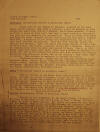
|
7.
12 December 1933.
Monograph of
Nicaragua. US Marine Corps
Intelligence Division (sections on
Atlantic Coast), p. 7.
"Cities & Towns,
Cont. (600 Section) . . . ¶
MUSAWAS .
. . ¶ Located at the headwaters of the
Waspuc River; 6 leagues or 10 hours to
San Pedro de Pis Pis; 3 days by boat to
Waspuc (Bucbuc), 3 days by trail to Wawa
Central. The trails are overgrown
with brush and are swampy.
Population about 350 Indians, all
Liberals. The people were friendly
toward the marines and Guardia.
There are about 65 houses all of bamboo
with thatched roofs except the Moravian
missionary’s house which is built of
rough lumber. Water is taken from
the Waspuc River. This is purely
an Indian community, Indians exist off
the fruits of the land and do not work.
They raise beans and bananas.
There are no stores. The only
prominent citizen is Rev. Karl
Bregenzer, the Moravian missionary and
citizen of the United States. He
was always very friendly with the
marines and has offered his services as
intelligence agent of the Guardia."
[NOTE:
This was obviously written before 31
March 1931, when the EDSN under Pedro
Blandón killed Bregenzer at Musawas.]
|
|
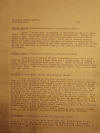
|
8.
12 December 1933.
Monograph of
Nicaragua. US Marine Corps
Intelligence Division (sections on
Atlantic Coast), p. 8.
"Cities & Towns,
Cont. (600 Section) . . . ¶
SACKLIN .
. . ¶ Town is located on the Coco
or Wanks River about 50 miles west of
Cabo Gracias a Dios; 2 days by motor
boat to Puerto Cabezas; overland route
from Puerto Cabezas to end of the
railroad 70 miles, means of reaching
Sacklin from Puerto Cabezas would be to
go to the end of the railroad by motor
car (rail) thence northward over what is
known as the Cuyutigne trail, by mules.
Mules are available at the end of the
railroad line – time required, 12 to 14
hours. Population about 100
Nicaraguans and about 800 scattered
Indians. The people were friendly
toward the Guardia and the marines.
There are 30 crude native shacks and one
small general store. Water is
taken from the river. Health
conditions are poor. A majority of
the Indians work for the Bragmans Bluff
Lumber Co., and on the Company’s banana
lands. A few cattle are raised.
¶ Adolfo Cockburn, store owner,
Liberal, half Indian and English, is the
prominent citizen. Cooperates with
the Guardia. ¶ . . . " [NOTE:
Again, obviously written before Cockburn
was implicated for his affiliation with
the EDSN and before his death at the
hands of the Guardia in October 1931.]
|
|

|
9.
12 December 1933.
Monograph of
Nicaragua. US Marine Corps
Intelligence Division (sections on
Atlantic Coast), p. 9.
"Cities & Towns,
Cont. (600 Section) .
. . SANG SANG
. . . ¶ Town is located at
the mouth of the Sang Sang Creek on the
Coco River. Aguasbila 5 leagues
upstream, 4 hours by power boat; 1-1/2
hours downstream. Waspuc 9
leagues, 3 hours downstream, 1 day
upstream. Water is taken from the
river. Population 40 Indians, 2
Spaniards, 1 German and 2 English
negroes; mostly Liberals. The
people were very friendly toward the
marines and Guardia. There are
about 15 houses, 3 of wood construction
with metal roofs, the remainder bamboo
huts. There is 1 general store.
The natives raise only enough food for
their own needs. Economical
conditions are very poor. ¶
Prominent citizens: A. E. Webster, owner
of Plantations, neutral, friendly;
Alberto Martinez, operates a general
store, Liberal, friendly."
|
|

|
10.
12 December 1933.
Monograph of
Nicaragua. US Marine Corps
Intelligence Division (sections on
Atlantic Coast), p. 10.
"Cities & Towns,
Cont. (600 Section) . . .
WASPUC . .
. ¶ Town is on the Coco River at
the mouth of the Waspuc River. Sang Sang
5 leagues; upstream 12 hours, downstream
3 hours. Sacklin 25 leagues,
downstream one (1) day. Cabo
Gracias a Dios 33 leagues; downstream 30
hours, upstream 4 days. Musawas 6
days by pulling boat up the river.
There are no trails along the river
above Sacklin. Population 80
Indians, 20 Spaniards and about 6 other
foreigners, mostly Liberals. The
people are very friendly toward the
marines but suspicious of the Guardia.
There are 5 houses in the town but
approximately 50 within a radius of 1
mile along the river banks. All
houses are of bamboo with thatched
roofs. There is 1 general
merchandise store. Economical
conditions are very poor. There is
very little employment and practically
no money in circulation. Waspuc
was a marine garrison for about two
years during the occupation and was used
as a forwarding station for supplies to
the stations further up the Coco River.
¶ The principal citizens were:
Allen Miller, Liberal, manager of a
general store, friendly to the marines
and Guardia; Edwin Fagot, owner of a
power boat which brings supplies to the
stores, U.S. citizen, assisted the
marines and was friendly to the
Guardia."
|
|
LETTERS
OF FRANK HILTON
NOVEMBER-DECEMBER 1933
|
|
Note:
These "Letters of Frank Hilton" and the
accompanying maps appear here thanks to
the kind courtesy of Jeff Ehler of West
Des Moines, Iowa, who got in touch in
October 2024 after discovering and
consulting the materials on this website
for a book he is writing. His
introductory email reads in part:
"Dr. Schroeder,
"I
have thoroughly enjoyed perusing your
website (The Sandino Rebellion) and
appreciate you putting all this
information together. My
interest in the subject comes via a long
term (+40 years) research effort into a
set of over 100 letters I possess that
were written to my great uncle in
1928-1936 from a railroad friend of his
named Frank Hilton.
"Frank
was born in Minnesota and met my great
uncle in Iowa working for the Chicago
Great Western RR. In the 1920's Frank
went to Venezuela to work in the oil
fields there (Shell) - primarily in the
Cabimas area on the lake. He returned to
the US due to the depression but in
spring, 1933 asked my great uncle to be
his US contact as he was intent on
walking from the US to Maracaibo,
Venezuela overland through Central
America. He made his way
south, coming into Nicaragua around
November, 1933...of course all illegally
as he had no money and thus no proper
visa stamps in his passports.
"Some of his letters outline his
travails in getting past the Nicaraguan
Guardia as well as maneuvering around
and past so many locals there that had
significant anti-American dispositions.
His path went from Cape Gracias a Dios,
up the Wangke River from Kruta to Tipi,
then overland south to Auka, then to
Saklin on the Wangke River. Then he was
helped by a West Indian on a cattle
ranch and made his way to Moss - then
hidden on a Standard Fruit Co. train
into Bragman's Bluff. From there he took a few boats to
Bluefields via Prinzapolka. Eventually,
after 10 months, he made Maracaibo - the
whole trip exposed him to officials,
bandits, crocodiles, jails,
missionaries, Meskitos, and two brushes
with death due to sickness.
"So the reason I'm writing is to ask
about your photos and images - are they
available for public use in a book I'm
writing? What would be the process of
gaining permission? I didn't know if you
were the copyright holder of any of
these. I just thought I'd ask. . . . "
I was happy to give Jeff Ehler
permission to use any images from this
website as he sees fit, asking only that
he cite the source. He has kindly
consented to allow this website to house
the six of Frank Hilton's letters that
describe his experiences in Nicaragua,
along with the maps he put together that
trace Frank Hilton's convoluted path
across the Caribbean Coast region of
southern Honduras and Nicaragua in
November and December, 1933. I am
grateful for Jeff Ehler's generosity in
sharing this material. The images are
JPEG scans of the originals.
|
|
|
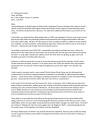 |
1. 10 November 2024.
Introduction to
Frank Hilton's
Letters.
Email from Jeff Ehler to Michael
Schroeder, p. 1. "To: Michael
Schroeder ¶ From:
Jeff Ehler ¶ Re:
Frank E Hilton Letters re: Sandino
¶ Date: 11/10/24
¶ Mike, ¶
I am emailing you six (6) pdf
copies of letters that I’ve gleaned from
my collection that relate to Frank’s
travels across the Honduran-Nicaraguan
border (Kruta-Cape Gracias region) in
November/December 1933. The letters
basically tell his story but I can add
some additional information to put them
all into context. ¶
Frank Hilton was originally from
Minneapolis (born in 1891 and migrated
to Clarion, Iowa (north central part of
the state) where he joined two brothers
and worked for the Chicago Great Western
RR there – from about 1907-1920. He left
in the late teens to work in Seattle and
then in California in the oil fields
near Coalinga. He had married for a
brief spell but divorced in 1923 and
made his way to Venezuela in that year –
working his way through Central and
South America. ¶ He
worked in Venezuela from 1924-1931,
occasionally returning to the States on
leave. When the depression hit the
Venezuelan oil concessions he returned
to the US and spent two years their
looking for work. In early 1933 a friend
from Cabimas wrote him that work was
picking up again and Frank decided to go
back to the Maracaibo lake area.
¶ However, he had no
money and no way to secure the necessary
visas that Venezuela, and the many
Central American countries, required. In
his earlier trek in the 1920’s the
border entry requirements apparently
were very lax but in 1933 things had
tightened up such that “legal” entry
wouldn’t be possible. ¶
Frank turned to my great uncle, a man
named Charles Payne (Noisy Payne was his
nickname) and convinced him to monitor
his progress back to Venezuela as he
intended to walk overland the whole
distance. Frank would write a
travelogue, and Noisy would be an
emergency contact should anything go
awry. Noisy kept all the letters (100 in
all) and I have them in my possession.
¶ Frank swam the Rio
Grande near Rio Grande City, Texas, in
late May, 1933, making his way down the
eastern Mexico coastal plain, walking
across the Yucatan, into British
Honduras and Guatemala and then
traipsing across the northern border of
Honduras. He almost died a few times
from infectious boils – once in Belize
and once in Tele, Honduras, but
eventually recovered with the help of
United Fruit Company personnel (among
other US companies) and eventually came
into the Kruta area where he met several
Moravian missionaries (see the first
letters). ¶ These
letters I’ve provided track his efforts
to first get past Cape Gracias a Dios,
which failed with a jailing, and then
his “end run” to the inland along the
Rio Kruta and down to the Rio Coco near
a town called Saklin, where he was
hidden and protected by a West Indian
manager of a cattle ranch. He ended up
in Moss (in hiding) and rode the narrow
gage train into Bragman’s Bluff –
eventually going by boat from there down
to Prinzapolka, Corn Islands, and then
Bluefields. ¶ The letter
addressed to “Franklin” was another
friend from Little Rock, Arkansas, who
Frank also wrote to and my great uncle
Noisy and Franklin exchanged several
letters with most all of them ending up
in Clarion, Iowa. . . . "
|
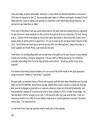 |
2.
10 November 2024.
Introduction to
Frank Hilton's
Letters. Email from Jeff
Ehler to Michael Schroeder, p. 2.
" . . . Frank
eventually arrived in Maracaibo,
Venezuela, in April, 1934, and
lived/worked there until around 1936
when he returned to the US. He
eventually settled back in California
working for Standard Oil until WW2 when
he moved to Vallejo and worked as a
steamfitter at the Mare Island Naval
Shipyards. He retired to LA and died
there in 1960. ¶
From many of his letters Frank was quite
opinionated on the Latin Americans
seeing them as ungrateful for the
enormous money invested into the
countries through the business
concessions, for fruit, mining, and oil.
I believe he felt mistreated by many of
the native authorities in that the
border Guardia were always aiming to
either jail him or deport him. I’m not
an expert on the social/economic
histories of the US vs. Central American
countries so have no opinion other than
feeling there’s always two sides to
every squabble and Frank, I think, saw
mostly his own side. ¶
These letters I’m sending (along
with some crude maps of his path) can be
used by you on your website to add to
its full library of original documents.
These are pdf’s of Word documents I’ve
created by manually transcribing them
from the original hand written letters.
. . . ¶ You
mention also writing a book someday so
if you can use these that would be fine
(just appreciate citing me and the
“Letters of Frank Hilton” if possible).
¶ My own book is a
narrative history of Frank and my great
uncle and their deep friendship over the
years (both met on the CGW RR). Noisy
Payne married, settled down, lived in
Clarion his whole life, had two kids,
several mortgages, a good job as an
insurance salesman, served on the board
of education, and was essentially a
bastion of his community until he died
suddenly in 1953 of a brain hemorrhage.
His two kids died in 1955 in a head-on
car crash. I only knew his wife, my
great aunt Bernice. Frank, as I
mentioned, died in LA in 1960 of a heart
attack, living alone in a hotel
apartment and wasn’t found for several
days. Two disparate lives. ¶
Let me know if you have any
questions and/or need scans of the
originals. ¶ Jeff"
|
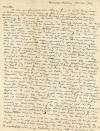 |
3.
21 November 1933.
Frank Hilton,
Wahamlaya,
Nicaragua, to Chas (Charles "Noisy"
Payne), Clarion, Iowa, p. 1.
"November 21st,
1933. ¶
Wahamlaya, Nicaragua. ¶
Dear Chas: ¶
To clear up a few points while they
are fresh in mind: On my arrival in
Caukera, - a small Indian Village of
four houses, I learned that a mile
further along the trail was located the
home and church of a Moravian missionary
by the name of Mr. Heath. This gentleman
I learned had pioneered in missionary
work among the Meskito Indians of the
area for the past 30 years. He has
translated the New Testament to the
language of the Meskitos - his has been
a real studious effort toward teaching
these primitive people the civilized
faith and ways of the white man. He is
known all thru the Lagoon sections of
Nicaragua as well as far into the
interior. I wanted to meet this man - to
see and draw my own conclusions as to
what manner of man he could be.
Anyone that could possibly interest
themselves in the welfare of such a
squalid and primitive race, in such
impossible living conditions was of
interest to me, and too, I've read at
times varying articles on the merit of
missionary work among savages, but never
did I have the opportunity until now to
see at first hand the activity of the
actual field work. Due to a
hard storm I was unable to visit him on
the day I rested at Caukera - but the
following day about 8:30 I came out of
the jungle country into the clearing of
his compound just as suddenly as that.
Here was located a bamboo and thatch
church, his home and out buildings, and
being Sunday there was groups of Indians
waiting for services at 9-00 a.m. The
home of Mr. Heath was a small well-built
cottage which showed at a glance the
decorative hand of a good house wife.
Curtains were draped in the windows and
flowers and ferns were set out around
the porch. Indeed a great sight to one
who has been living in mud and thatch
houses for weeks. I introduced myself to
Mr. Heath and in turn was introduced to
his wife - both received me warmly and
sincerely and begged me to rest a day
and night with them, but I had three
Indians waiting on the trail for me who
I wished to use as guides and I liked
their services, so I declined. Instead I
had a short visit with them and was
impressed with the keen sincerity of
their work.
Mr. and Mrs. Heath are aging people,
both are white haired and kindly folk.
Both are keen students of their work and
it would be hard to find two people
better fitted for the tedious effort
that is theirs. In a motherly way, Mrs.
Heath insisted that I take a lunch to
carry with me on the 21 mile walk to
Cruta and she busied herself in its
preparation. The while I visited with
Mr. Heath. Too bad indeed that my stay
was so short as I found him to be
wonderfully interesting. Naturally his
very life is centered in his . . . "
|
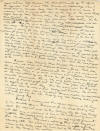 |
4.
21 November 1933.
Frank Hilton,
Wahamlaya,
Nicaragua, to Chas (Charles "Noisy"
Payne), Clarion, Iowa, p. 2.
"[. . . centered
in his] work and our talk concerns the
accomplishments of his efforts. He
requested that I visit their Mission at
Wahamlaya where I would meet an American
lady that he referred to as our nurse. I
promised that I would, and here we are
now at the small thatch roofed home of
Miss Kreitlow, where I've again been
warmly treated. Miss Kreitlow has had
over eight years among these Indians.
She has mastered their language and
helped translate Christian songs into
Meskito. Here too, is a sincere,
studious woman, patient towards her
work. Daily she has school classes,
church services and domestic science in
sewing for the younger Indian girls.
Evenings there is a school class for
young men to whom she is teaching the
elements of the three R's. She tells me
that she has some now doing long
division in Arithmatics, and from what
I've seen of the Meskitos, that is
indeed remarkable. The Indians are keen
to acquire knowledge and attend their
classes with interest. At the moment
there are 15 young Indian girls and boys
going thru their elementary exercises on
the porch of this small home which she
uses as a classroom. Their hair is
combed and all wear neat homemade
clothing. After weeks of seeing them
with nothing but a 3" breechcloth on,
this looks like real progress to me.
¶ Besides her teaching, Miss
Kreitlow has a small medicine house
where she mixes and dispenses medicines
for all their ills. She is dentist,
doctor, and pharmacist and this is a
real service in a country where there is
so much sickness and infection. I marvel
at the real patience of one who can for
years live alone in such primitive
surroundings. She is the only white
woman in hundreds of miles of primitive
jungle and I'm more than glad that I
have had an opportunity to meet her.
Then too, along with her busy life, she
finds time to raise a few turkeys and
chickens, has a small producing garden,
over a hundred banana suckers are now
planted and with all she has the help of
only two native Indian girls and a young
boy. ¶ Relative to
missionary work here, my own experiences
in the villages of the Meskito offers a
background for the actual field of their
effort. For days and weeks I've been
travelling thru this tribes territory
and this area is estimated to have in
the neighborhood of 20,000 Meskitos.
Their actual living conditions are only
slightly removed from the animals. They
make a cloth of bark that they pound to
a pulpy state. This cloth is about 30
inches in width and the women of the
tribes wrap the lower part of the body,
from the hip to the knees in this
material. . . . "
|
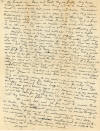 |
5.
21 November 1933.
Frank Hilton,
Wahamlaya,
Nicaragua, to Chas (Charles "Noisy"
Payne), Clarion, Iowa, p. 3.
"[. . .
material.] The breasts are bare, and
Lord! they are filthy. They know nothing
about cleanliness. They're lousy and the
hair on their heads is matted with dirt,
grease, smoke and ashes. The children
run naked until they are 10 or 11 years
of age, then they wear a breechcloth
only 3" wide thru the crotch of their
legs. The one active thing about them is
their breeding. Every hut is full of
children. Just as soon as nature will
allow it, another is on the way. The
navel cord is cut long, protruding from
their bodies some 2 inches and with all
they are a sight. ¶ Another trait is
their ability as gorgers. When large
game is killed, as a deer for instance,
it must be eaten right away. They make
absolutely no preparation for any other
than one meal at a time. They could sun
cure this meat and have provision for
weeks - but instead gorge themselves to
the point of sickness, eat every bit of
it if it takes 3 or 4 days. Then they go
without food for several days. A Meskito
wouldn't carry an armful of wood to his
fire - he would rather wait until the
dying embers were so low that they must
be fanned and blowed to a flame and then
one stick at a time. Even in the bad
weather recently, they would leave their
hut and bring back one small piece of
wood at a time. When there is no game,
then coconuts and yucca are eaten. Wabul
is made and this taken little effort to
get. Game is killed with bow and arrows
- even birds. They are extremely adverse
to any work, require no money and will
bargain with you only for tobacco in
exchange for what they can offer. An
ordinary tobacco leaf here is worth 10¢
gold. For 1 leaf I can get 2 chicken
eggs or a dozen bananas, or 1/2 dozen
coconuts, or a meal of yucca and
plantanos. It traded at the store here
at 10¢ the leaf for anything on the
shelves. Tobacco is money and my tobacco
is fast losing its weight. ¶ It's
getting late and I've five miles to
paddle back to Cruta before dark. I
leave here with a small bottle of
Iodine, some boric acid powder and
quinine. These I've wanted badly and
Miss Kreitlow fixed me up this small
package of medicine on her own
initiative. The Meskitos can wait until
a later date. I will be in the
neighborhood of a month to 6 weeks
getting to Porto Limon, Costa Rica - so
write to me in answer to letters now
being received. ¶ Frank."
|
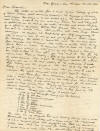 |
6.
25 November 1933.
Frank Hilton,
Cabo Gracias a
Dios, Nicaragua, to Siesel A. Franklin, Little
Rock, Arkansas, p. 1.
"November 25th,
1933. ¶ Cabo Gracias a Dios, Nicaragua.
¶ Dear Franklin: ¶ This letter is
written from a small Indian village of a
tribe of Meskito Indians called
Wahamlaya (meaning in the language of
the Meskitos-wild grapes). Cape Gracias
is 23 miles distant and is the nearest
place with mail service. I will be my
own mail man between here and there, and
an optimistic one at that as I've
written 5 letters and haven't the price
of a stamp in my pocket. But in Cape
Gracias there are several white men and
on arrival there this problem will solve
itself. Here at Wahamlaya I've accepted
the hospitality of a lady missionary to
stay a week or two to rest up and get my
feet in better shape for travelling. The
detail in connection with the 200 mile
walk from Honduras into Nicaragua I've
written in another letter to my friend
Payne in Iowa. I requested that he mail
the letter to you for your interest in
this part of my trip, and in turn you
can mail it back to him after you have
read it. This for the reason that Payne
is keeping a file of my letters to him
and from the whole experience these
might be sufficient material for a book.
However, you are in the dark relating to
the preparation I made before heading
into the jungle on this last leg of my
trip and briefly I will give you an idea
now, that you may be able to reconcile
the letters with what happened before. I
wrote Payne from Sico, Honduras, where I
stayed overnight with a United Fruit Co.
Supt. and in the letter from there I
enumerated the articles I was including
in my pack for the 225 mile walk to Cape
Gracias, Nicaragua. Carrying my own
supplies was an absolute necessity as
there isn't a place to buy food in the
whole distance. Among other things I
carried were: ¶ 5 lbs. of leaf tobacco
(for trading with the Meskitos) ¶ 2 1/2
lbs. of salt pork ¶ 2 lbs. of compressed
oatmeal ¶ 1 1/2 lbs. of coffee ¶ 2 lbs.
of sugar ¶ 2 cans of Nestles sweet milk
¶ 1 lb. of salt ¶ 1 can of pepper ¶ 2
cartons of cigarettes, ¶ 2 lbs. of 1ima
beans ¶ Then there was my mosquito bar
and cooking utensils, also a small
blanket and my toilet articles and a
clean shirt. The whole made up into a
compact pack that weighed 32 lbs. This
was carried in a rubber sack that here
is used for travelling, and if necessary
I could swim a river with the lot and
still keep my stuff . . . . "
|
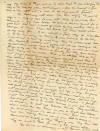 |
7. 25 November 1933.
Frank Hilton,
Cabo Gracias a
Dios, Nicaragua,
to Siesel A.
Franklin,
Little Rock, Arkansas, p. 2.
"[. . . my stuff]
dry. My letter to Payne, which he will
mail to you will give the story as to
how my plans materialized. For the
moment a few lines re this spot and a
look to the immediate future. The
Missionary with whom I've been staying
the past 5 days is a lady of some 50
years and hails, of all places, from
Minnesota - my home state. So we are on
common ground for a good visit. And
after a couple of weeks of very
primitive living I want you to know that
hot biscuits and home cooked dishes are
my daily fair - to me, almost a fairy
story. At the time, I was indeed in need
of everything. Even the rubber sack had
been traded for plantanos and yucca and
it was looking as tho my next meal would
have to be land crabs or whatever I
could forage on my own. The Meskitos are
friendly but they know nothing about
helping out one another. Theirs is an
attitude that, as they must forage
primitively so must everyone else, and
several times I have watched them eat a
big meal - but never did it occur to
them to ask me to eat too. For a leaf of
tobacco I could get anything they had.
One even wanted to trade a cow for 3
lbs. of tobacco. Tobacco is their money
and they will trade anything they have
at ridiculous bargains. Tobacco in
Nicaragua is exceptionally dear. A
monopoly is held on the native tobacco
grown here and a package of inferior
cigarettes sells for 25¢ gold - this in
a country where $1.00 gold is big money
for 12 hours of work. And the Indians
are strictly adverse to any manual
effort. Hunting, fishing and wild yucca
and plantanos are plentiful and life is
easy. For yucca and plantanos I traded 2
leaves of tobacco - receiving 8 or 10
plantanos and about the same number of
yucca. For one leaf I got two eggs and
while my tobacco lasted I fared well
enough. But to be without tobacco is
just like having no diners in the good
old Estados Unidos. They can't believe
that a white man can become so poor as
to not have tobacco. You could easily
read the doubt in their faces when I
would tell them that my tobacco was all
gone. And no dealing is terminated so
abruptly as their bargaining once they
learn that they are unable to trade for
some of the precious stuff. So here I am
at Wahamlaya, - and tomorrow I will walk
. . . "
|
 |
8. 25 November 1933.
Frank Hilton,
Cabo Gracias a
Dios, Nicaragua,
to Siesel A.
Franklin,
Little Rock, Arkansas, p. 3.
"[. . . I will
walk] the 23 miles to Cape Gracias and
will spend Thanksgiving there. From Cape
Gracias I anticipate a ride on one of
the United Fruit Co.'s boats to
Bragman's Bluff, Nicaragua some 65 or 70
miles further south. The same means of
travel I will offer itself from B. B, to
Bluefields, Nicaragua and from there
I'll have another stretch of hard going
to Costa Rica. I should with any kind of
luck, make Porto Limon, Costa Rica for
X-mas, and have set that as my goal. So
you have ample time to write to me there
in care of Listo de Corrios, I've
written another letter to Miss Putman
from here and requested that she, too,
make my X-mas a bit more merry by
writing me an X-mas letter to that
address. Then I will have mail from
Venezuela and Iowa and California and
that will make my X-mas complete. My
physical self is perhaps better at the
moment than at any time in the long hard
trip to here. I'm as hard as nails, eat
anything and can stretch out on the
ground and enjoy a real nights rest.
Nicaragua at the moment is quiet. There
are several brutal bands of bandits
roaming the interior who call themselves
Sandinistas - but Sandino disowns them.
They have murdered several Americans and
they are especially vicious to American
subjects. Nicaragua is still
disorganized in policing the country.
One has to be prudent here, as the
feeling still persists that the
Americans have robbed them of their
birthright. Ignorance is played up to by
anyone who wants to stir up trouble and
they are easily incited to pilfering and
worse. The coastal area isn't as bad as
the interior in this respect and I look
for no trouble other than what might be
my lot re passport difficulties in the
event that I'm called on to be looked
over. So this then gives you an idea as
to what I wrote to Payne – also plans
for the future. You will receive the
letter I wrote to Payne – a 10 page
epistle, so with that - My merry X-mas
and Prosperous New Year to you. ¶
Frank"
|
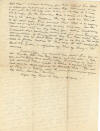 |
9. 25 November 1933.
Frank Hilton,
Cabo Gracias a
Dios, Nicaragua,
to Siesel A.
Franklin,
Little Rock, Arkansas, p. 4.
"Old Man - I
recall answering your letter rec'd at
Tela, Honduras in which you had placed a
one dollar bill. True enough, it was a
godsend but its only when I am on the
hike do I really have to suffer for the
necessities. Once I arrive at a Camp of
any of the Foreign Companies then my
wants are taken care of in short order.
Rest assured that there is no urgency
that won't right itself upon meeting
white men. For this reason don't send me
any help in your letters. Fortunately I
received that particular letter,
otherwise some barefooted Administrador
of Corrios would have been $1.00 richer.
These countries have no Dead Letter
Dept, as we have in the north. Mail is
finders keepers to them once it’s not
called for. So in the future -
regardless of tone of things - I'll
survive. Incidentally, I've received two
letters from you on this trip. One at
Vera Cruz, Mexico and the other in Tela.
You undoubtedly have written others but
change of route etc. prevented their
receipt. I believe I explained the mail
question with reference to Suchiate,
Mexico. This sort of thing is in keeping
with the poor mail service of all the
Latin American countries. Again say
hello to all - Frank."
|
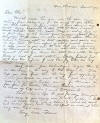 |
10.
11 December 1933.
Frank Hilton,
Moss Farm, Nicaragua,
to Chas (Charles
"Noisy" Payne), Clarion, Iowa, p. 1.
"December 11th,
1933. ¶ Moss, Nicaragua. ¶ Dear
Chas: ¶ Much water has gone over the dam
since writing from Wahamlaya. Too much
to give details at this writing.
Suffice, that I have survived my most
trying experience to date. Here at Moss,
I again make contact with the world.
Moss is end of rails on a fruit line of
the United Fruit Co. running west from
Bragman's Bluff some 100 miles into the
interior. Here I'm indeed in a vicious
spot, as both soldiers and police are on
my trail. To run afoul of either would
mean a long period in jail and I've had
one experience of Nicaragua jails - more
re. this later. For the moment to let
you know I'm still alive altho I'm again
badly in need of doctors attention.
Badly festered feet that have been
infected with blow-fly bites are my
worst worry. ¶ My letter from Wahamlaya
- I gave then to an American on his way
to New Orleans, La. I do hope you have
received them. On my first opportunity I
will give details re. events to here.
Just now I'm in hiding in a most hostile
country for Americans. I'm fair game for
Soldiers, Police, and Bandits, and
without a chance of help until I reach
Bragman's Bluff. ¶ Lord! what a life.
The past few days I was just about ready
to give myself over to either of them -
but now it's another story. I've a
chance to reach the coast and contact
Yanks, and the old spirit is inclined
that way more than ever. ¶ Say hello.
Frank"
|
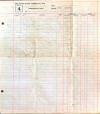 |
11.
11 December 1933.
Frank Hilton,
Moss Farm, Nicaragua,
to Chas (Charles
"Noisy" Payne), Clarion, Iowa, p. 2.
[The blank
"Bragmans Bluff Lumber Co., Inc.
Merchandise Dept." invoice sheet upon
which was written, on the flip side, the
foregoing letter.]
|
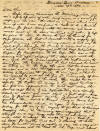 |
12.
13 December 1933.
Frank Hilton,
Bragmans Bluff, Nicaragua,
to Chas (Charles
"Noisy" Payne), Clarion, Iowa, p. 1.
"December 13th,
1933. ¶ Bragman's Bluff, Nicaragua. ¶
Dear Chas: ¶ Before leaving Wahamlaya
the Missionary worker gave me a 4 ft. by
8 ft. piece of water proof canvas as a
covering for sleeping in the rain. This
stood me in good stead many times up
until I was compelled to trade it to a
Meskito Indian for food. Along with the
canvas, she made a small sack of the
same material and when I left her place
to return to Cruta to get the launch for
Cape Gracias, she had it loaded with a
supply of food. Arriving at Cruta on my
return I had only to wait a few hours
for the launch to arrive, and in just a
short time I had arranged with the West
Indian Negro Captain for transportation
to the Cape. This was in the evening and
after sleeping there that night with the
crew of the launch, I was surprised the
next morning to learn from the Captain
that he had changed his mind on taking
me to the Cape. He said that as I was an
American and as that the officials at
Cape Gracias were bitterly antagonistic
to Yanks, he was afraid that he too
would be put on the fire for helping me.
If I was any other but a Yank, he said,
there would be no trouble. The Captain
was sincere in his effort to help me but
fear was uppermost in his mind and when
the launch left Cruta, I was left
standing in a swampy marsh, in water and
reeds about 2 feet deep. Never have I
felt so forlorn as when I waived to the
crew good-by. There wasn't a blessed
thing in Cruta but the Commandante1s
shack, so again I bargained with an
Indian for the use of his cayuca to get
back to Wahamlaya. Arriving there the
Missionary again requested that I stay
for 3 or 4 days longer with her, as she
knew, she said, that I would be unable
to get a boat from the Cape for another
week and I decided to settle down for
another period of waiting as rain was a
day and night occurrence and the trail
to the Cape went inland . . . "
|
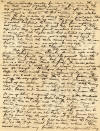 |
13.
13 December 1933.
Frank Hilton,
Bragmans Bluff, Nicaragua,
to Chas (Charles
"Noisy" Payne), Clarion, Iowa, p. 2.
"[. . . went
inland] thru a swampy country for some 8
or 10 miles. This, I was told, would
probably prevent me from making the trip
afoot until better weather. But after a
3 day wait and a lull in the bad
weather, I again started out. The 8 or
10 miles of swamp covered a great plain
that was flooded by months of rain. The
going was slow and I walked barefooted
to save my feet from softening in wet
shoes, I was unable to cover the 25
miles to the Cape that day, night found
me about 8 miles from there. I could see
the lights and had extended myself in
reaching there but darkness put a stop
to my effort. I slept on the trail, the
canvas covering over me, and the rain
beat a tattoo on me all night. At
daylight I was on my way and arrived at
the Cape at 7:00 a.m. Cape Gracias is
one of the oldest towns in the western
Hemisphere. Here Columbus landed after a
stormy voyage - his fourth, and like the
present time, the weather must have been
bad, for he named it Cabo Gracias a Dios
(Cape Thank to God). The small place is
located on a delta of the Wangke
(pronounced Wan-ke) river. The Wangke is
Nicaragua's largest river. Here at the
Cape it's three mouths cover an expanse
of low country some 5 or 6 miles in
width. It's a dismal, forlorn and out of
the way afoot. Its houses, mere shacks
in the worst of condition - Indians do
what little trading that is done here
and in its population of some 100
whites, blacks and Indians, there are 3
Americans there. To one of these I
enquired my way - a Mr. Hendricks who
was in charge of a Radio Relay Station,
and he was glad to have me stay with him
for a few days - he would arrange
passage to Bragman's Bluff on the
arrival of the next launch and in the
meantime he thot it best that I see the
Captain of the Guardia Civil for my
second Visa. He said, that as I already
had an entry Visa at Cruta, he felt
certain that the Captain here at the
Cape would fall in line, which in turn
would eliminate any further passport
difficulties along . . . "
|
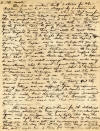 |
14.
13 December 1933.
Frank Hilton,
Bragmans Bluff, Nicaragua,
to Chas (Charles
"Noisy" Payne), Clarion, Iowa, p. 3.
"[. . .
difficulties along] the coast. So, like
an unshorn lamb, I started for the
Captain's Quarters but was stopped by 2
soldiers who asked the regular questions
re. where I had come from, my
nationality, and about my passport. When
I showed them my passport and they saw I
was a Yank, they told me I was under
arrest and I was taken to the Barracks
of the Guardia Civil. A young Lieutenant
did the questioning on arrival there and
altho he could talk good English, he was
most discourteous - insolently so, I
requested that I be brought before his
commanding officer and in a few minutes
I was a taken to the Captain's Quarters.
The Captain was a man perhaps 45 years
of age - and as soon as I saw him I knew
definitely that I was up against a tough
proposition. He was given my passport
and altho he couldn't read English he
knew that it was an American Passport.
In Spanish he said that he didn't
recognize Americans under any
circumstances; that he would request the
Major at Bragman's Bluff, his superior
officer, that I be returned to Honduras
as Nicaragua had had all the Americans
they wanted, and it was his pleasure to
see that I walked the 350 miles back to
Sico, Honduras. I wasn't given a chance
to do any talking. And the tone of
things was so different from any
experience that I've had previously,
that I looked on and listened with keen
amazement. Before I realized it, I was
marched back to the Barracks and put in
a hard wood cell that contained 3 other
native prisoners. This cell was the
guard house for the detachment of
soldiers stationed at Cape Gracias. It
was about 12' by 12' square with no
windows. The only light that came thru
to us was light thru cracks in the
boards of the walls. There were no beds
or cots, and no sewerage or drinking
water. In the day time it was a hot,
damp and stinking hole, and night time a
haven for mosquitoes and other . . . "
|
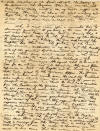 |
15.
13 December 1933.
Frank Hilton,
Bragmans Bluff, Nicaragua,
to Chas (Charles
"Noisy" Payne), Clarion, Iowa, p. 4.
"[. . . and
other] pests. We slept on the floor and
ate the leavings of the soldiers in the
Barracks. This food was rice and beans
twice daily with a can of terrible
coffee in the mornings. There was no
chance to wash or shave and before the 6
days were up that I spent there, I was
looking more like a wild man than a
human. When I didn’t return after a
reasonable time to Hendrick's quarters,
he got busy on his own to find out what
had become of me, and on learning that I
was locked up he went to the Governor of
this District to intercede in my behalf.
The Governor out ranked the Captain but
there was the question of the Civil and
Military authorities in my case, and the
Military side of the question had
encountered me and of course I was there
prey, until such time as the Governor
would be able to move to higher
authority in the capital at Managua. He
requested that I be sent to him for an
interview and I could see the
crestfallen expression on both the
Captain and his Lieutenant as I was
taken under guard to the Governor's
office. The Governor was a sincere and
earnest man. He said my treatment was
unfair; that he alone had authority to
pass on passport difficulties, but that
he had no cooperation from the Captain
of the Guardia Civil and he would do all
possible to undo the damage the Captain
had already done in his wire to
Bragman's Bluff. All the Foreigners in
Cape Gracias got behind my case - there
were seven of them, and they offered to
stand all expenses necessary to
circumvent the Captain. He was keenly
disliked by all of them, and they were
all present when I entered the
Governor's office. The Governor sent a
lengthy wire to the Capital, also a
letter to the Major here at B. B. and
during the time that these were being
dictated, a soldier entered with a
message from the Major here, in which he
ordered that I was to return to Honduras
over the route I had come. That two
soldiers were to accom- . . . "
|
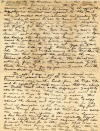 |
16.
13 December 1933.
Frank Hilton,
Bragmans Bluff, Nicaragua,
to Chas (Charles
"Noisy" Payne), Clarion, Iowa, p. 5.
"[. . . were to
accom-] pany me to the Honduras border,
and that I was to start out the
following morning. The Governor read
this message and then dictated his
answer to the effect that my physical
condition was impaired to the point
where I needed medical attention and
pending the time when I would be able to
travel he would be responsible for my
safe return to Honduras. He, of course,
was fighting for time and an answer to
his message to the Capital. So I was
taken back to my cell in the Barracks
and 3 days later was informed that the
Capital had held up the decision of the
Major here and I would be compelled to
return. Upon learning this an American
came to visit me and gave me $5.00 in
gold, also 2 lbs. of leaf tobacco for
trading with the Indians and that
evening I was told that the Governor had
arranged transportation on the same
launch I had missed in Cruta. This
launch was returning from Bragman's
Bluff on its regular schedule to the
Cruta River and for my guard I would
have the Commandante of Cruta. So after
6 days in jail I was released under
guard and placed aboard the launch. The
Cruta Commandante was another breed from
the Cape tribe and he sympathized with
me - even told me about an Indian trail
that, altho difficult, I might be able
to use to circle this area, and make
Bragman's Bluff in some 10 days to two
weeks of walking. This I decided to do,
and on arrival at Cruta, I slept aboard
the launch and left the next a.m. for
the head of Navigation up the Cruta
river. My first Indian Village, from
which the trail led was called Tipi,
some 90 miles upstream. This point is
located in a bad bandit country and I
was repeatedly begged not to attempt
this hard and dangerous trip. That I
would be killed for no other reason that
I was a Yank and that feeling was
extremely bitter thru the country I
would be in, as the American Marines had
. . . "
|
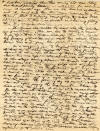 |
17.
13 December 1933.
Frank Hilton,
Bragmans Bluff, Nicaragua,
to Chas (Charles
"Noisy" Payne), Clarion, Iowa, p. 6.
"[. . . Marines
had] been stationed thru that country
and that they had killed plenty natives
in retaliation for ambuscades some 10
months ago. Here was the hide-out of
Sandino and his band and here too many
Marines had been killed. But I certainly
wasn't going to walk back the 350 miles
to Sico - so decided on chancing getting
thru this dangerous country. The launch
was unable to reach Tipi the first days
run from Cruta. This was due to towing a
small barge that had a deeper draught
than the launch. We finally got stuck on
a sand bar about 15 miles below Tipi and
from this point I was on my own. In a
drizzling rain I bargained with two
squaws to take me in their cayuco to
Tipi. They finally agreed to do so for
10 leaves of tobacco and in a short time
we left the stranded launch and paddled
up the swift moving stream. The current
was just about all the two squaws could
make any time against. At times we
barely moved and night came on while we
were still 3 or 4 miles from Tipi. We
made a lean-to shelter on shore, roasted
some bananas on our fire and put in a
night that was a torment due to pests.
The following day we made Tipi about 11
a.m. and after paying the squaws their
tobacco, I headed into the jungle. I
arrived at a small village for the night
and the next day got an early start for
Auca some 7 or 8 miles further along.
Here at Auca I would have to bargain
again for a cayuca to take me 15 miles
further up the Cruta river. Arrived in
Auca I made a deal with two young
Indians to take me to Stromlaya - from
this point the current is so swift that
even cayucas are out of the question and
walking would be my lot for some 30
miles to the Wangke river. The two
Indians were about 17 or 18 yrs. of age
and huskies. For 15 leaves of tobacco
and 5 Nicaraguan nickels they agreed - I
to paddle also. . . . "
|
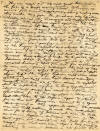 |
18.
13 December 1933.
Frank Hilton,
Bragmans Bluff, Nicaragua,
to Chas (Charles
"Noisy" Payne), Clarion, Iowa, p. 7.
"[I to paddle
also.] They were experts and we made
good time even in the face of a swift
moving stream. Whenever we couldn't pass
around exceptionally strong rushing
water they used a long pole to push out
way up stream. Finally arrived at
Stromlaya and stayed there overnight. At
daybreak again afoot on the trail to
Strombul on the bank of a lagoon some 15
miles away. I arrived that p.m. after a
hard day of wallowing thru mud and
brush. My shirt and trousers were torn
in shreds and I looked my worst. Grass
cuts had cut my legs and hands and these
were painful and inflamed. Arriving at
the Lagoon I shouted and shouted but
received no answer from the opposite
shore - some 1/2 mile away. I was hungry
and tired and decided to walk back about
3 miles to a patch of bananas that I had
passed, so as to have roasted bananas
that p.m. and for another effort to
raise some passing Indians on the other
side of the Lagoon. What a night I put
in, in that spot! Tapico kept the night
hideous with their shrill whistling -
pests of all kinds droned around my
mosquito net and 4 or 5 times during the
night I had to replenish my fire to keep
off animals that would sniff and snort
in the darkness. Glad indeed for the
first rays of light in the early a.m.
And then back to the lagoon. Again I
shouted for an hour and finally was
answered by a squaw that passed on the
opposite shore. She paddled over and
with motions I made her understand that
for 2 leaves of tobacco she was to take
me across. Agreed - and soon I was on
the trail again and arrived on the north
bank of the Wangke river that afternoon.
Again a long period of shouting to
attract Indians on the further bank . .
. "
|
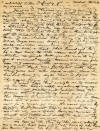 |
19.
13 December 1933.
Frank Hilton,
Bragmans Bluff, Nicaragua,
to Chas (Charles
"Noisy" Payne), Clarion, Iowa, p. 8.
"[. . . further
bank] and about 5 p.m. I finally got an
Indian to take me across, I'm now in
Nicaragua again and of necessity I must
avoid all contact with authorities and
the native Spanish as they too are bad.
So on the opposite shore I learned that
I was 3 miles west and north of Oori and
that Saklin, headquarters for a
detachment of Guardia was located 3
miles further away. That I would have to
pass thru both places and I decided to
try to do this just after sundown. I
also learned that there was a west
Indian Negro overseer looking out for a
big cattle ranch some three miles back
from the river and I took a trail that
turned out to be a cow trail to the
river and followed it thru the jungle
bordering on the river to a great
savannah country covered with virgin
pine trees. I wallowed thru swampy, tall
grass, My legs and hands were freshly
cut with this wiry grass and when dark
settles down I headed toward a light
that I figured was the ranch house for
the cattle ranch. I must have been a
sight as I walked up to the house with
my shoes over my shoulder - my pants and
shirt torn to pieces and a growth of
beard on my face. The Negro - he
couldn't do enough for me. A warm meal
and a place under a roof to sleep and
rest for a couple of days. He would get
me by Saklin - but I must hide - no one
was to see me - he was sure that, being
an American I would meet with sure death
to encounter any Spaniards in this
district, He told me the story of this
ranch, showed me a nicely kept grave out
in the back of the house. His Master's
grave. He had been shot by one of our .
. . "
|
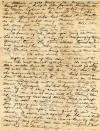 |
20.
13 December 1933.
Frank Hilton,
Bragmans Bluff, Nicaragua,
to Chas (Charles
"Noisy" Payne), Clarion, Iowa, p. 9.
"[. . . by one of
our] Marines in cold blood - this
because he was caught giving help to the
bandits hereabouts. So I was right in a
hot bed of bad feelings. But the Negro
said, he couldn't blame the Marine
Sargent who had killed his Master as he
knew that many Marines had met the same
fate and during the time that this was
going on everything was fair. I learned
of the death of a young U.S, Marine
Lieutenant who was in charge of a
company of Native Guardia Civil. The
native soldiers turned on him and
murdered him. They then all went over to
the Sandino side - many other such tales
and even now - it's still death to
Americans. After a rest of two days he
planned to leave the next a.m. at 2:00
o'clock. He would give me a saddle horse
to ride and he would go with me until
daybreak - he knew the trail thru the
savannah country and by hard walking
from the point where he would leave me,
I could make end of rails out of
Bragman's Bluff at Moss, Nicaragua. We
had half a moon to ride by and a starry
clear morning. Must have covered some 15
or 20 miles with him. Passed thru the
village of Oori and Saklin deep in sleep
and on into a great plane covered with a
fine grazing grass and yellow pine
trees. Leaving the Negro after warm
good-byes and many thanks, I struck out
afoot for the rail head arriving there
after some 12 or 13 hours of hard
walking. My feet were raw and infected
and this trip was tortuously painful. .
. ."
|
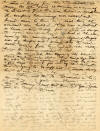 |
21.
13 December 1933.
Frank Hilton,
Bragmans Bluff, Nicaragua,
to Chas (Charles
"Noisy" Payne), Clarion, Iowa, p. 10.
"[. . . painful.]
So in hiding from the Commandante at
Moss. At this point 13 American
employers of the Standard Fruit Co. were
killed in cold blood. The company
Commissary was robbed and burned down 6
times and each time the attendant was
killed. Here was a district in terror -
and today feeling still is dangerous
against all whites. I hid in the store
room of the commissary there. Again a
Negro was my keeper and 2 days later the
road-master came up from here and I rode
with him on his small speeder to
Bragman's Bluff. I'm now in the main
office of the Standard Fruit Co. and
will rest in their camp here till I'm
able to travel again. That will be in a
few days. I must get out of this
district and its going to be difficult.
I will do my best to write when I can. ¶
Chas. send this to Franklin as he can
return it to you. --- Thanks. And a
Merry X-mas Old Man to you, yours and
the Baby. Frank."
|
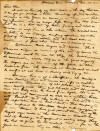 |
22.
13 December 1933.
Frank Hilton,
Bragmans Bluff
(Puerto Cabezas), Nicaragua,
to Chas (Charles
"Noisy" Payne), Clarion, Iowa — second
letter of the day — p. 1.
"December 13th,
1933. ¶ Bragman's Bluff, Nicaragua. ¶
Dear Chas: ¶ I wrote so hurriedly my
letter earlier in the day that now I can
give you perhaps a better knowledge of
true conditions in so far as the Yanks
are concerned in these parts. Lord! my
information was so meager before coming
here that I now find I'm in a hot bed of
bitter feeling and that no American is
safe here in the interior. The coastal
area is better, as all Foreign company
operations are under guard of Nicaraguan
soldiers and at least order is
maintained. I find that there are 3
classes of race here. Spaniards, Creole
Negroes, and Indians. The 3 classes are
citizens or Natives of Nicaragua, and of
course the Spaniards want to run the
ship. The Indians receive no
consideration, altho they are in the
great majority. The Negroes are on the
side of the Yanks as their treatment
from the Spaniards is terrible and one
must be careful at all times in dealing
with any of these. Business here is at a
standstill - the country is under
martial law and rumors are ripe re.
another revolution. Sandino is, of all
places, in Mexico cow-towing with their
cut throats, and I'm predicting that
this baby will be heard from again. He
is an out and out communist as well as a
ruthless killer. His reputation here is
bad indeed. This company has been
compelled to abandon camps and equipment
in the terrain I have just passed thru.
One of the largest saw mills in the
Americas is located here and its
buildings and equipment is wasting away.
They too had to quit. So it's evident
that as far as the Yanks are concerned,
they are thru in Nicaragua. . . . "
|
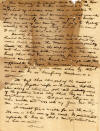 |
23.
13 December 1933.
Frank Hilton,
Bragmans Bluff
(Puerto Cabezas), Nicaragua,
to Chas (Charles
"Noisy" Payne), Clarion, Iowa — second
letter of the day — p. 2.
"[. . .
Nicaragua.] This company (the Standard
Fruit Co.) has lost millions here and
the lumber investment is in the
neighborhood of 10 million more. This in
addition to the cost of valuable land
concessions, which never will again be
worked by Americans. I'm going to
breathe easier once out of this country.
It's going to be plenty interesting to
do that very thing, but for the moment I
don't want to think about it. Banditry
here is vicious - people killed are
always hacked to pieces with machetes
and I heard of some terrible deaths. The
Marines couldn't possibly locate the
bandits in the deep jungle. Aeroplanes
were used here with very little result.
Then the same bunch that had been
responsible for an ambuscade would come
out of the bush and mingle with those
supposed to be loyal to our soldiers.
Treachery was the keynote of the whole
biz. And no one can be so harmfully
treacherous as a Spaniard. It's best
that this part of the world is
completely forgotten insofar as its
possible. Let them stew along in their
own pot, and probably some of the
greatness which they think they are -
will eventually wear off. But just now
they are in the saddle and woe unto any
Yank that they can work on. I wouldn't
give a nickel for all the country I've
seen in this neck of the woods. It's
primitive and impossible to live in. And
a country without order is hell on
earth. Frank."
|
 |
24.
14 December 1933.
Frank Hilton,
Bragmans Bluff
(Puerto Cabezas), Nicaragua,
to Chas (Charles
"Noisy" Payne), Clarion, Iowa, p. 1.
"December 14th,
1933. ¶ Bragman's Bluff, Nicaragua. ¶
(Puerta Cabeza.) ¶ Dear Chas: ¶ Odd
perhaps, that one runs into a name of a
town in these parts such as the above.
But originally the place was called
Puerta Cabeza. A bad fire a few years
ago burnt the Native village down, while
the Company's holdings were left intact.
For that reason the name gradually has
been changing to Bragman. Everything
here is owned by the Standard Fruit Co.
A small Native village of thatch huts
has sprung up, but no stores of business
of any kind are done there. The dock for
ships is owned by the Company as is the
Post Office, school and even the Church.
Bragman was an American that organized a
large lumber company under his name. The
company prospered in the good years,
1915 - 1929 - but since has been going
to rust. The Standard Fruit Co. a few
years ago bought the Bragman Concession,
and now they are trying against great
odds to make a banana growing section of
the cut over timber country. In this
they utilize the logging Railroad that
was built by Bragman, - the same I rode
on coming from Moss. Only the later maps
show this place under its present name -
but you can find Puerta Cabeza on most
any of the older maps, ¶ I learn that 40
miles south of here at a place called
Prinzapolca there is a company also
organizing to cut mahogany - and when I
reach there I will again have to go into
the interior about 100 miles to a place
called . . . "
|
 |
25.
14 December 1933.
Frank Hilton,
Bragmans Bluff
(Puerto Cabezas), Nicaragua,
to Chas (Charles
"Noisy" Payne), Clarion, Iowa, p. 2.
"[. . . a place
called] El Gallo, From there it's a
day’s walk to a river that again leads
back to the coast at Rio Grande, and
from there to Bluefields its only 160
miles following the coast line, but
going into the interior is some 200
miles further. The reason - I can get a
boat probably most of the way to El
Gallo, and from there I again am in line
for a lift from United Fruit Co. boats
to Bluefields. So with any kind of luck
I should make better time going the long
way, as the beach trail to Bluefields is
hard and dangerous, ¶ My feet and other
places of infection are coming along OK.
Swelling and inflammation are leaving
fast - and in a few more days I can
travel. In the meantime I'm in good
status. Americans here have taken over
all my worries as to living, and I will
most likely leave here with a new outfit
of clothes. The ones I have aren't even
fit for rags. My shoes are still in good
shape considering the grief they have
been thru. They are easily the heaviest
pair of shoes I've ever worn, and in the
rough going that I've done from
Honduras, they have stood it better than
my physical make up. ¶ So then, a peek
as to the future. ¶ Frank."
|
 |
26.
14 December 1933.
Frank Hilton,
Bragmans Bluff
(Puerto Cabezas), Nicaragua,
to Chas (Charles
"Noisy" Payne), Clarion, Iowa, p. 3
(envelope).
|
 |
27.
(Map — no date).
Frank Hilton,
sketch map of "Leg
44" of his travels by Jeff Ehler's
reckoning: route from Kruta to
Wahamlaya.
|
 |
28.
(Map — no date).
Frank Hilton,
sketch map of "Leg
45" of his travels by Jeff Ehler's
reckoning: route from Wahamlaya to
Cabo Gracias a Dios.
|
 |
29.
(Map — no date).
Frank Hilton,
sketch map of "Leg
46" of his travels by Jeff Ehler's
reckoning: route from Kruta to
Tipi.
|
 |
30.
(Map — no date).
Frank Hilton,
sketch map of "Leg
47" of his travels by Jeff Ehler's
reckoning: route from Tipi to Auca.
|
 |
31.
(Map — no date).
Frank Hilton,
sketch map of "Leg
47b" of his travels by Jeff Ehler's
reckoning: route from Kruta to
Tipi to Auca to Stromlaya.
|
 |
32.
(Map — no date).
Frank Hilton,
sketch map of "Leg
48" of his travels by Jeff Ehler's
reckoning: route from Tipi to Auca
to Oori to Saklin.
|
 |
33.
(Map — no date).
Frank Hilton,
sketch map of "Leg
48b" of his travels by Jeff Ehler's
reckoning: same route from Tipi to
Auca to Oori to Saklin.
|
 |
34.
(Map — no date).
Frank Hilton,
sketch map of "Leg
49" of his travels by Jeff Ehler's
reckoning: route from Saklin to
Moss Farm.
|
 |
35.
(Map — no date).
Frank Hilton,
sketch map of "Leg
50" of his travels by Jeff Ehler's
reckoning: route from Moss farm to
Bragmans Bluff / Puerto Cabezas.
|
|
|
|
|
|
|
|
PREVIOUS
NEXT |
|
|
|
|
|
|
|

